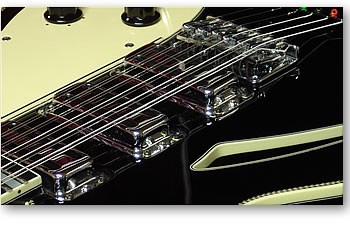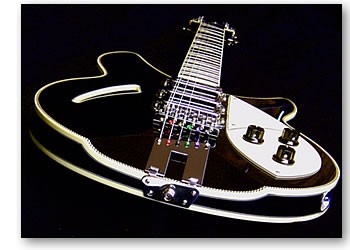Archive Builds
Click on the titles below to read all about them.
2017 Solido
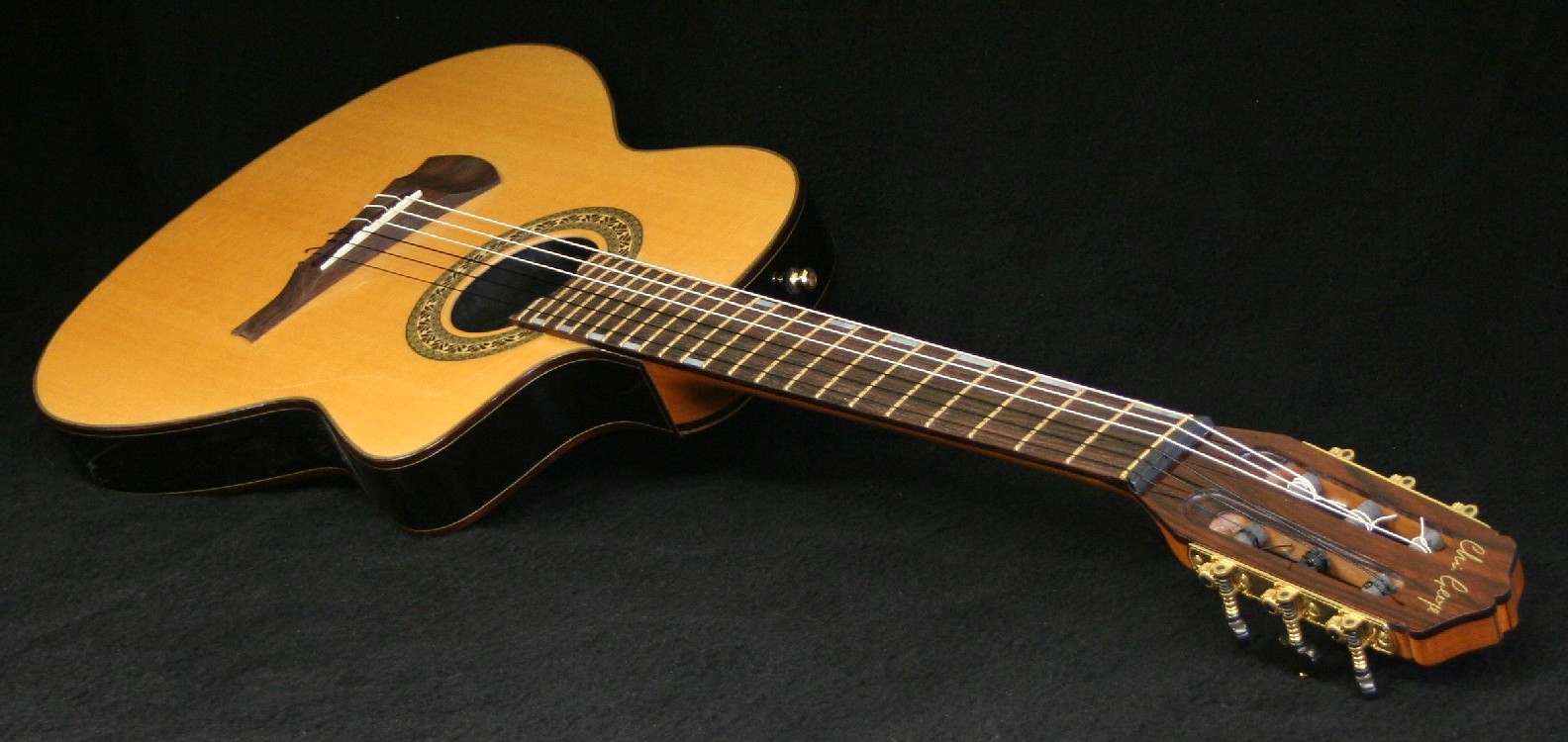
I had an enquiry from a semi pro gigging musician who wanted to add some "Nylon" into his set. He was worried that they played quite loudly and a normal nylon strung acoustic with a pickup wouldn't cut it. As I had had some success with a hybrid steel strung electro I was confident all would work out. The body would be swamp ash but heavily chambered for lightness but not for too much resonance, with a spruce top. It would be 14 fret to body, with a zero fret and a narrower cambered fingerboard to feel more like an electric guitar. Way back in the past I had an admiration for the Gibson Chet Atkins electro and the Gibson Mark guitars that were only in production for a few years, and I "borrowed" from both. The simple under saddle pickup system was the Fishman Matrix Infinity with its endpin preamp. Volume and Tone controls were mounted on the inside top edge of the "soundhole". The build was straight forward and lightly embellished with rosewood bindings and a rather classic looking rosette. The bridge was rosewood with black graph tech saddle. The tuners were Rubner with black rollers and buttons.
The guitar worked very well and was featured in Guitarist Presents Acoustic mag (Spring 2017) Who concluded "Pros:- Design,build quality and highly feedback-resistant electro voice"
Couldn't have put it better myself! In fact I liked it so much I have built myself one, although a bit flashier!
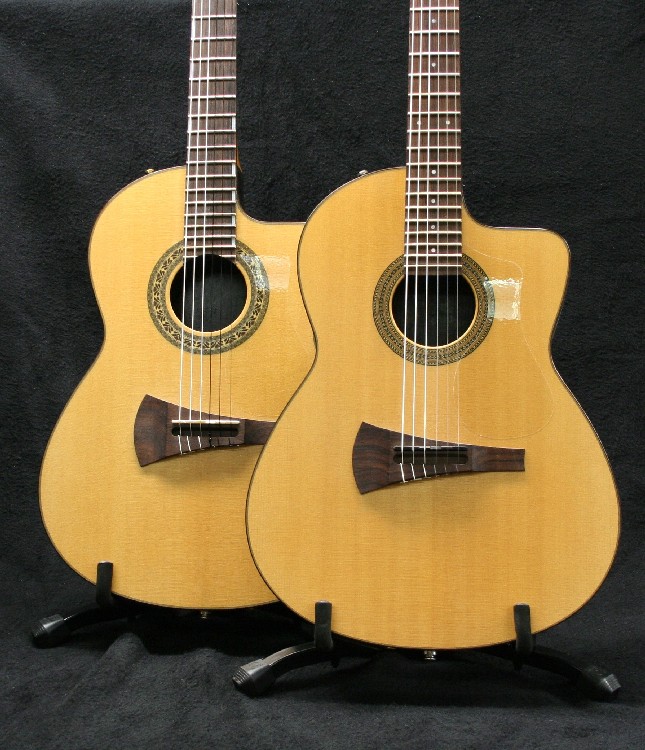
2015 Cape Verde Cavaquinho
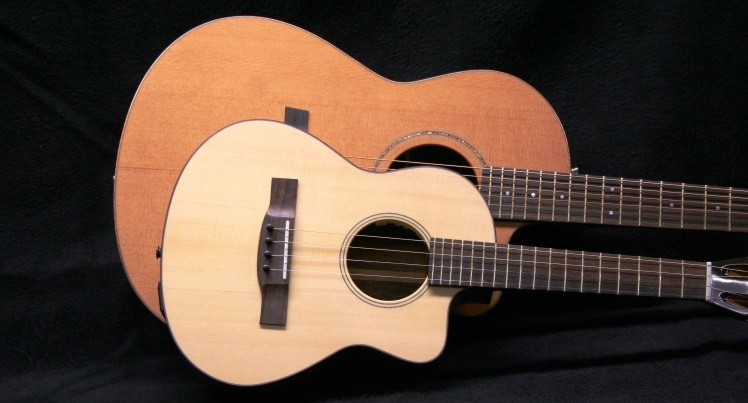
About a year ago, I was asked if I would build a Cape Verde Cavaquinho. My reply was ,"A what?"
I'd never heard of such a thing. Apparently it is a Brazilian Ukulele, tuned to the first 4 strings of a regular guitar but an octave higher. Like a fool I agreed and then set about trying to find some information on such an instrument. After searching the usual places, there were pictures of some construction using very rudimentary tools and techniques but the size and dimensions could only be approximated by studying pictures and guessing how long a person's forearm was and extrapolating from there. We settled upon a scale length that looked 'right' and the build took place.
The back and sides were amazaque (also known as ovangkol), the top was sitka spruce and the neck, mahogany. The bridge, fingerboard and head facing were macassar ebony. I decided on a pinned bridge, although most 'real' cavaquinhos seemed to have 'tied' or string through bridges. With steel strings an octave higher, albeit with a short scale, I thought a pin bridge would be stronger.
As this instrument was for for stage use, it was fitted with an 'all singing and dancing' L R Baggs Anthem system (under saddle mic and piezo) which does seem a little a odds with the original humble intentions of a true Cavaquinho. All went well and the finished instrument was strung up. It was then that I realised just how much tension was required in the strings and a secretly said 'thank you' for my pinned bridge. A few broken strings later, it was decided to contact a string maker for advice and a few custom sets were put together.
The instrument sounds great, apparently very authentic and the pickup system compliments it. It still seems like a 'toy' to me but I am a bit of a 'stick in the mud'.
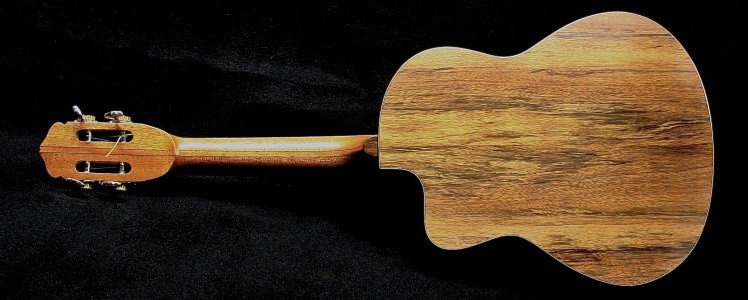
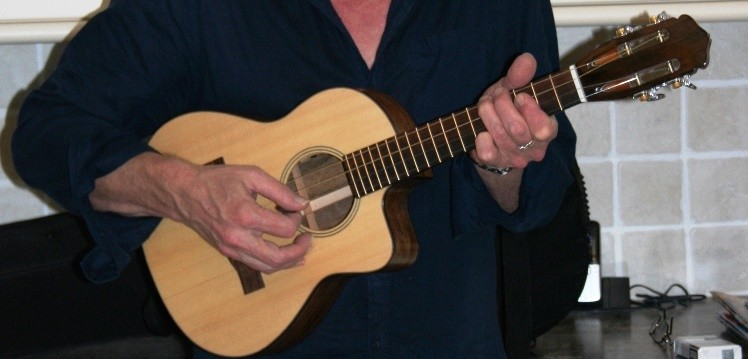
Zircote Stage Acoustic
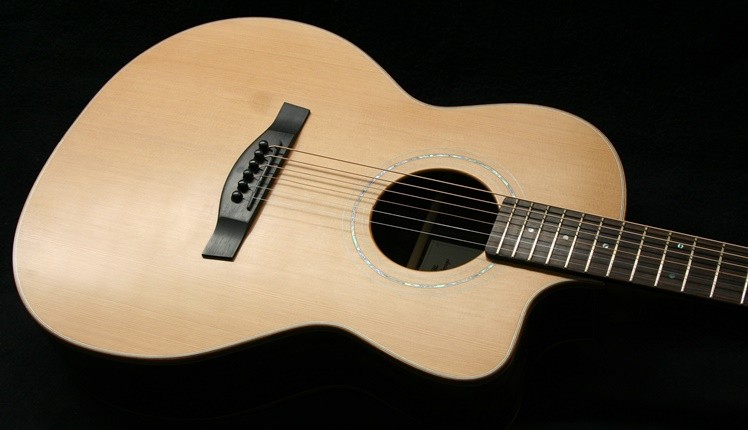
My reader(s) may recall a while ago, a guitar that started out as a possible acoustic commission but ended in a rather nice set neck, twin HB, S type. Well coincidentally, this one started as an electric slide guitar (with a suggested shape similar to Richard Thompson's green Ferrington electric) but this morphed into a rather beautiful acoustic featuring a "Manzer" style wedge body. It is a steel strung 25", scale cedar topped guitar with a B band piezo pickup system.
Chris, my client, owns quite a few top end guitars, including a very very nice Linda Manzer nylon strung acoustic and so I was able to have a good look at the "Manzer Wedge." Although I had done something similar with a baritone acoustic, I was impressed by her styling and indeed everything about the guitar, far more radical than my previous effort.
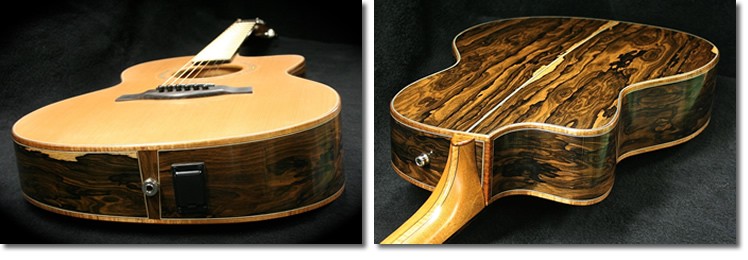
Chris chose ziricote for the back and sides and cedar for the top and binding to body and head were koa. The neck was mahogany with a figured maple centre splice. Fingerboard and bridge were macassar ebony. Ebony bridge pins, Waverly tuners, Schaller strap locks, black tusk nut and bridge saddle and an under saddle B Band pickup system completed the spec.
Because Chris is an accomplished guitarist (don't blush!) a cutaway was considered essential as was a 14 fret to body design to access the 'dusty end' of the fingerboard. The neck profile was taken from his trusty Lowden acoustic and the body shape was my 'parlour' sized acoustic but with added cutaway. I copied Linda M's wedge body but reduced the depth overall by about 5/8" (yes, imperial measurements - you youngsters go work out the metric conversion!). This was to help reduce any on stage feedback, much as I did with Dave Burrluck's CE-N acoustic (featured build Nov 2012). I also fitted a bridge truss system that I have used many times.
The finish was nitro cellulose with the cedar top and back of neck in satin, whilst the back and sides were hand rubbed gloss.
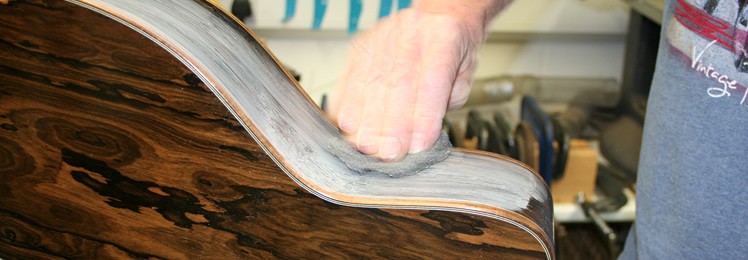
The finished guitar looked stunning and had a rather surprising 'full sound', (again rather like Dave B's CE-N). Plugged in, the B Band delivered the goods with little piezo 'quack'.
Most importantly, Chris says there is nothing that he would change at all about it, "best acoustic ever!". So why did it come in today to have the action slightly lowered!!!!
In truth I liked this guitar so much I have just built another to very nearly the same spec. It may appear for sale or it may well be added to my own collection, I do fancy it for a few Muskett gigs!
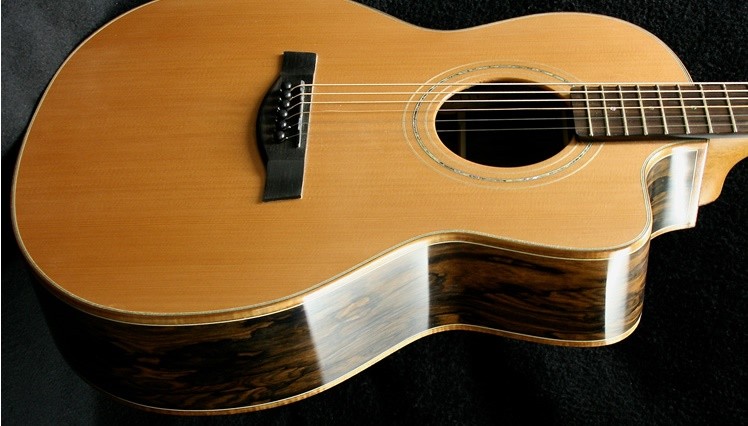
2013 Double cut carved top HSS electric
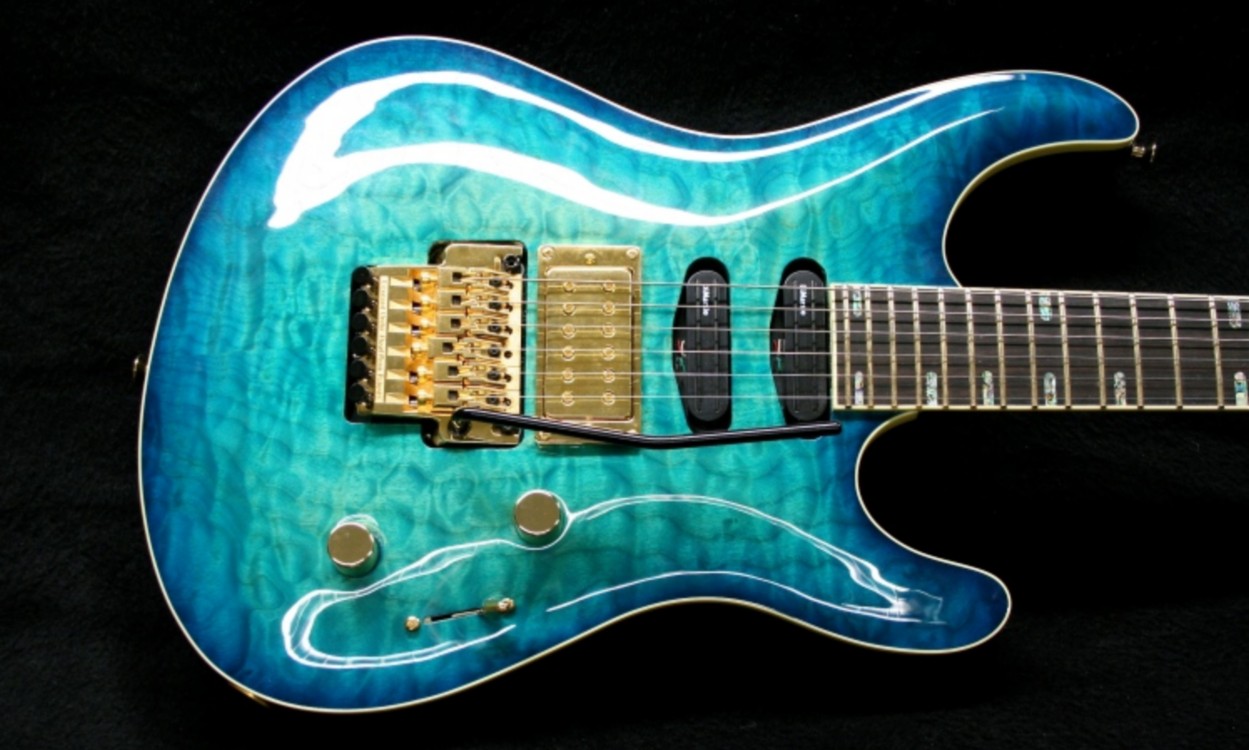
They never are as straight forward as one first assumes. This was to be a carved top, double cutaway, set neck, three pickup electric. The body shape was a combination of a Carvin CT624 and an Ibanez JS2400. We played about with various options, particularly the two 'horns' before settling on the final shape. The top carve was to be more PRS than Carvin and was something I looked forward to, especially as it was in my favourite material, quilted maple. All hardware was to be gold plated where available, and the jewel in the crown was an Ibanez edge low profile Floyd Rose floating trem. First hurdle was to find a gold plated one. Ibanez uk importers refused to sell me one, although if I'd lied and said it was a replacement on an Ibanez guitar, I would have been able to have one! Finally I contacted Thomann, and although it didn't appear on their web site, they said they could obtain one in gold. (I've always been very impressed with Thomann - really excellent, fast service)
I was then asked to add a Tremol-No locking device and an EV D Tuna. This is where things got sticky. I knew the Tremol-No would work, although the Trem cover would have to be altered to allow access but I had no idea about the D Tuna. I did try to find out via the various "chat rooms" but without any success. Without getting on my soapbox, why is it that folk put up so much absolute drivel? If they don't know, why start giving opinions? The search was a complete waste of time. I had obtained a D-Tuna and I couldn't see it being successful on the Ibanez. The EV site was slightly more helpful, although it didn't convince me 100% one way or the other. However, when I finally did manage to contact them and sent them a few pics of the Trem, I received a definitive "No". Now this is the sort of reply one wants. Luckily I hadn't routed the top for the device but it had taken about a week of procrastination.
The actual build went very smoothly and I was very happy with the top carve, the 'bellycut' and the heel-less set neck joint. (PIC 1B) Chris (customer) had decided on a turquoise stained top with a darker edge burst that would match the colour on the mahogany back, sides and neck. The headstock facing, also in quilted maple was to be matching. The staining went well and was shown off with the ivoroid bindings. I thought that the top didn't require a darker edge burst and said so but as it turned out, Chris was right, it did look better.
Colouring the mahogany to match proved much more difficult, maple being light and mahogany dark. I also wanted to cover the neck body joint and it took quite a while of experimenting until we were satisfied. The pickups chosen were DiMarzios, which I'd always associated with high gain and shredding. Just shows what I know. With coil cuts on all three via push/pull pots, 5 way switch and single tone and volume, the versatility of the guitar amazed me. The Temol-No caused a few problems, as they are designed for guitars with the body depth around that of a Strat. With a carved top on mahogany body, we were more into Les Paul territory and access to the device took a little 'fettling' and a few mock ups with cardboard trem covers were needed.
Overall I think the guitar is superb. For me I'd not have a Floyd type trem but that's down to my 'hand on bridge' way of playing. Aesthetically I'd have opted for a black surround on the bridge pickup and probably some different pickups but that's about it. More importantly is that Chris loves it - he had a vision of what he wanted and he stuck to it, that's the way it should be. Well done Chris.

2013 Plain Jane and Ben the Baritone acoustics
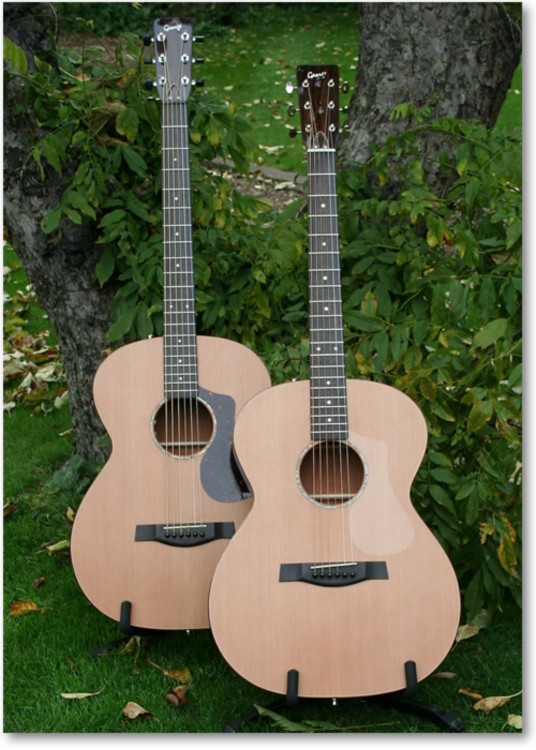
About a year ago outside a pub (a good start), I came across a superb British built acoustic guitar by a well known maker and what knocked me out about it was it's simplicity. Nothing fancy but everything beautifully done: simple bindings, simple purflings and a single abalone soundhole inlay, no neck or head bindings, no fancy fingerboard inlays, and it was simply stunning.
That, I thought, is an object lesson in taste. So ....................
I'd had a hankering to make a baritone acoustic for a while - because? - well because I'd never made one, so I thought why not make a, 'less is more', baritone acoustic. Typically I charged ahead, bent the sides and then..... thought about it. Now there seems to be no 'standard' scale length or even tunings for a baritone, although most seem to be B to B (as opposed to E to E standard tuning). Then I wondered if I should have made the sides deeper for better bass response. Also around this time I had a customer request an acoustic with the "Manzer Wedge" shape whereby the lower rim (side) of the guitar is deeper then the upper (see pic below).
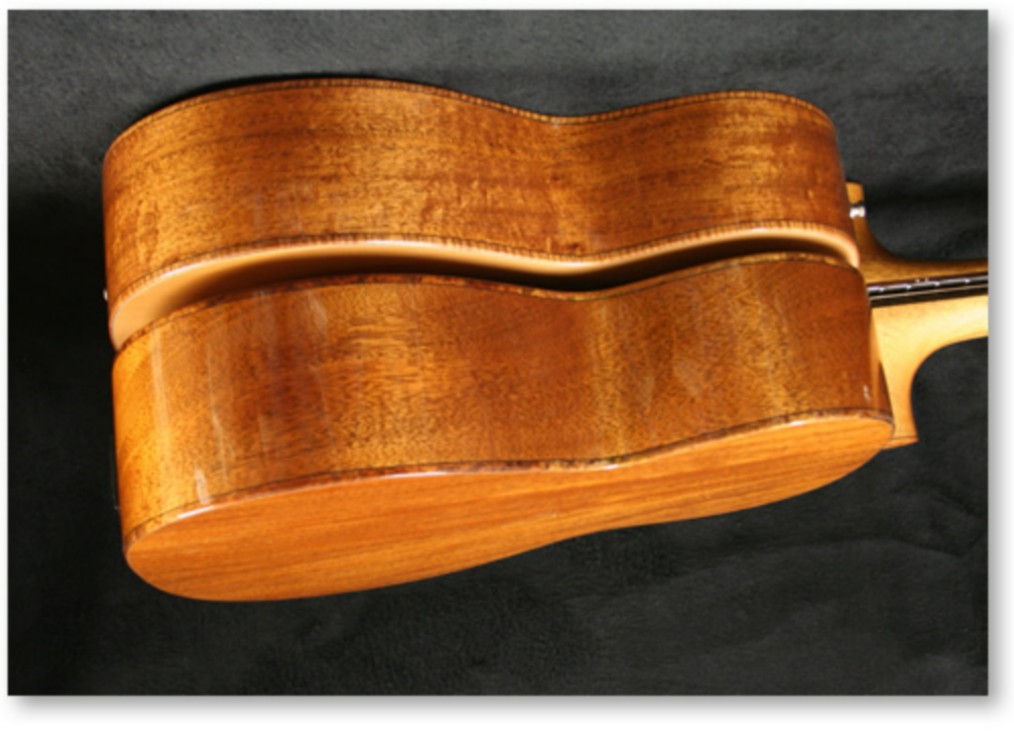
Hmmmm...... so the aforementioned sides were demoted and a new, deeper, set of sides bent.So the project encompassed two guitars, materials identical, African mahogany back and sides, Western red cedar tops and triple spliced mahogany necks with macassar ebony boards and bridges. The bindings were beautiful Koa on the baritone and Tazmanian Blackwood on the regular acoustic.
Both guitars were finished in nitro cellulose but for the first time ever, the fronts as well as the backs of necks were satin (I don't really like satin finished guitars) With the cedar tops, I had to eat my words as it gave both guitars a "Lowden" look (sorry George I did say "look" not "sound" or "feel". I have enormous respect for those guitars, one of the best ever acoustics I have played was a Lowden).
Both guitars pleased me. The baritone sounds much better via the pickup system, in much the way an acoustic bass guitar does, very rich, orchestral even.
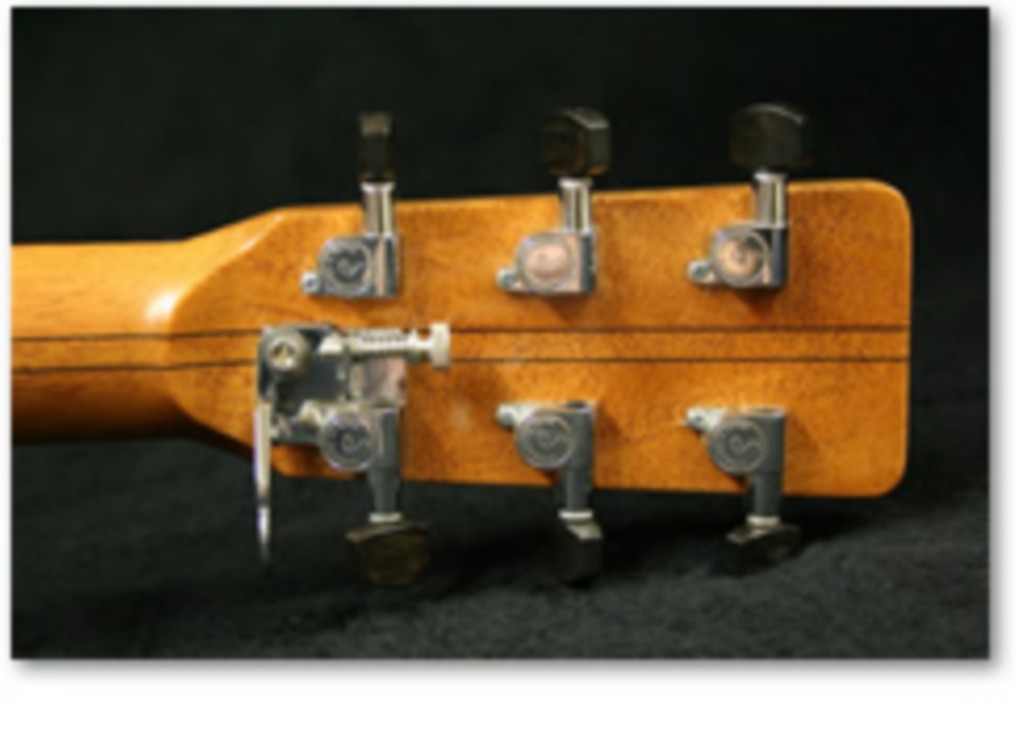
Plain Jane is just a light weight, sweet no nonsense player. At the moment it is strung with 80/20 Bronze 11's and I think it would be more suitable with phosphor bronze 12's so I shall give them a try. I did try to use "Ben" with Muskett on our recording session but it all seemed a little contrived so it will have to wait for its debut.
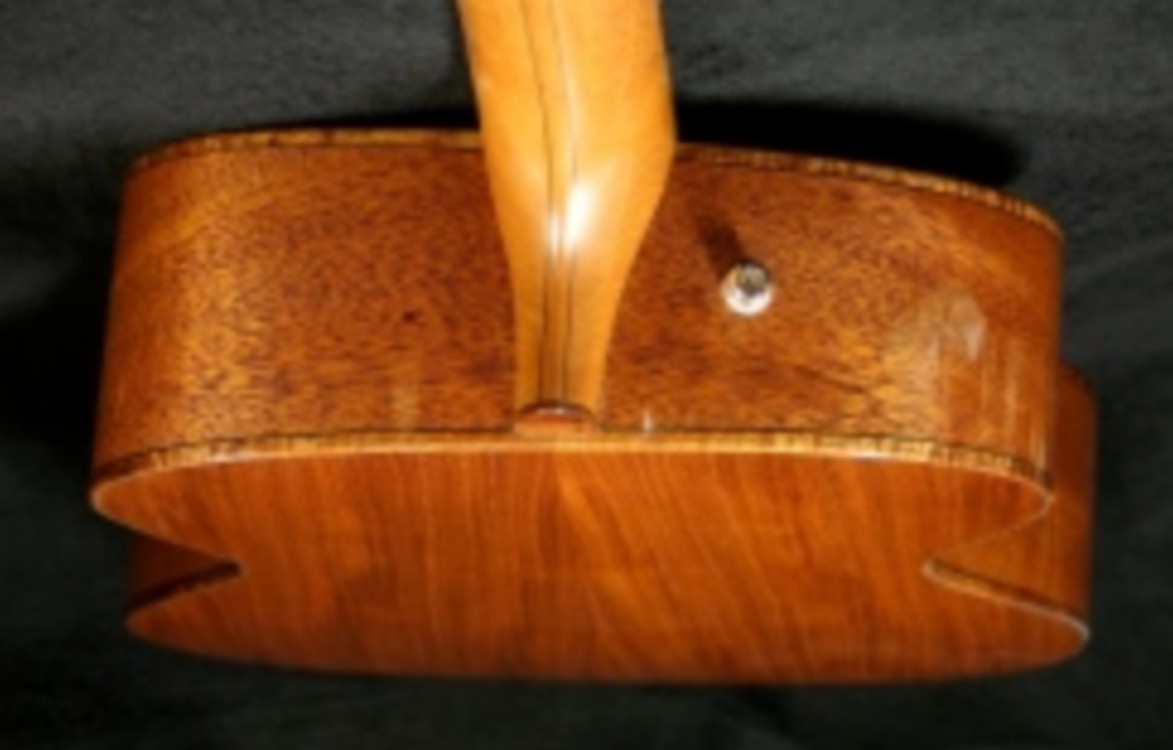
"Plain Jane" is offered for sale with full spec. elsewhere on my site.
2012 Triple pickup T style electric
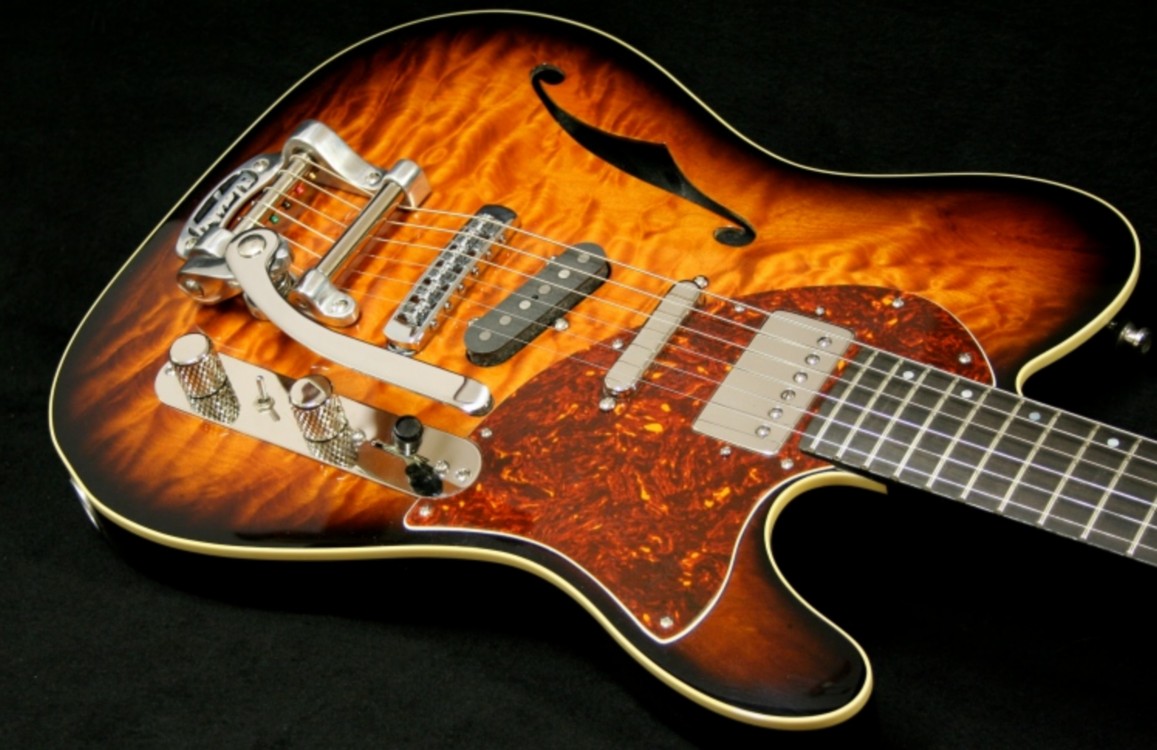
There is a warning here. To all of you who approach a custom guitar builder and have one guitar built to your specification, it will probably not be your last guitar. You'll come back for more. Or so it has been in my experience.
The "Splitguard" featured here was commissioned by Colin, who previously had a 'StarMaster' built (Featured build 5/2011) The spec was very much a set neck 'T' type thinline with single 'f' hole. Quilted maple top over a hollowed out mahogany body. A flamed maple neck, capped with an ebony board and the headstock a cross between my 'StarMaster' and a regular 'T' type and with the concave chamfer. A separate quilted maple headfacing was added to match the guitar's top.
Now why the 'Splitguard' name?
Well Colin wanted three pickups and a regular Thinline pickguard wouldn't accommodate the middle pickup. So we played about with a variety of designs and settled on my 'Splitguard' shape - a sort of hybrid thinline/regular 'T' type. Of course it didn't make life easy when it came to mounting the middle pickup but that's what we custom builders do. We (try to) make things work.
The pickup choice was interesting. Colin wanted a Tele set up covering the bridge and middle and a HB in the neck position. But the tele combination had to work together as one humbucker and separately as two single coils.
So................. a mini switch between the one vol and one tone control would, in position one, give 5 'Strat' like pickup combinations. And in position two, give 3 Les Paul pickup combinations, where the 'T' pickups were in series and acted like one humbucker.
Colin had specified Bareknuckle Blackguard '52 Tele pickups and an Abraxas bridge humbucker in the neck position which, when split, would give good single coil sound. I had a chat with Tim Mills (Mr Bareknuckle) to confirm phasing issues etc. and he wished me best of luck with the wiring! To cut a very very long story short I did sort the switching via a 4 pole double throw switch and it worked.
Single coil mode; bridge, bridge and middle, middle, middle and neck coil humbucker and neck coil humbucker.
Humbucking mode; switch positions one and two, bridge and middle pickup in series. Position three 'T' pickups as one HB and neck HB in parallel, positions four and five, neck humbucker.
Magic
!!The nitro cellulose tobacco edge burst was complimented by the tortoise pickguard and the 'f' hole followed my 'Vox meets Thinline' design. The headstock shape I feel will re-appear as I rather like it, a bit like the 'F' hole design.
So there it is the Splitguard.
Now Colin, what's next?
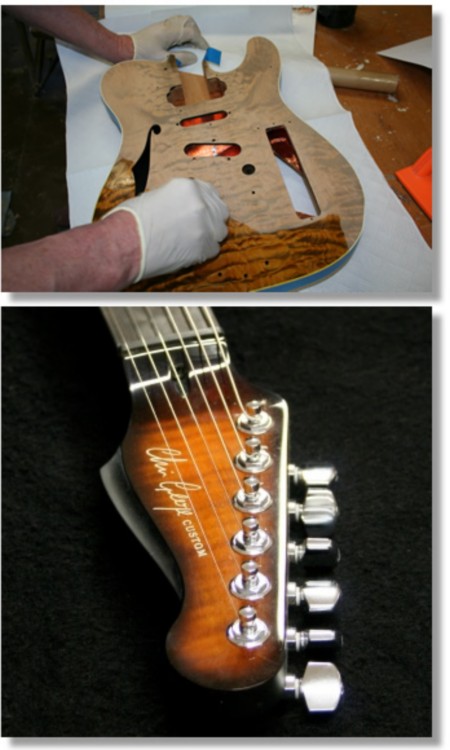
2012 Triple pickup Superbass
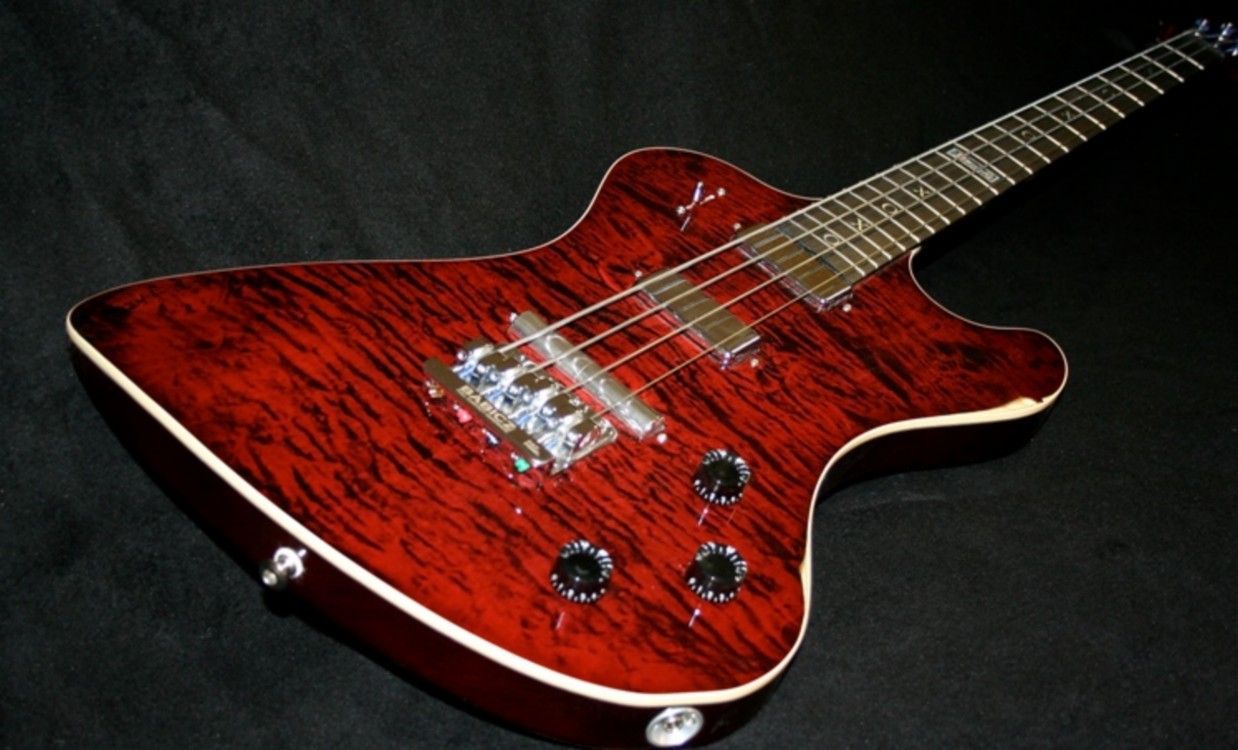
Long long ago in a land far away..............
In reality quite a few years ago I was approached by Terry and asked if I would restore an old steel string acoustic guitar. The guitar was itself quite ancient. It had a floating bridge and a bent steel tailpiece and all in all I didn't think it worth restoring as it would never be a thing of beauty or musicality.
Terry said it had belonged to his dad and so had a great deal of sentimental value and so of course I duly set about it. The guitar once finished was greatly appreciated by Terry, so another satisfied customer probably never to be seen or heard from again. Wrong!
Many years later I had a call asking did I make bass guitars. The honest answer was 'rarely'. I have only made about half a dozen but Terry explained who he was and that his daughter, Nina, was a bass player and was looking for something special. We arranged a meeting to discuss the possiblity and my heart sank as Nina had bought along a 'picture board' of details she'd like on the guitar.
The sinking heart was not in the detail but in the shape - it was a pretty close copy of a Gibson RD Artist bass that emerged in the early 80's only to quickly disappear, interestingly it has just appeared again in the form of an artist endorsed model. I did point out that the balance of such a design would never really work and the fact that Nina wanted 4 aside tuners meant that the design would be more neck heavy than the original two per side. However a challenge is a challenge and we agreed to the build.
It was to be a set neck design with the 'horns' of the mahogany body hollowed out to remove some weight and it was to have a quilted maple drop top. Nina wanted three pickups - yes - three. Two were to be humbuckers and one lipstick single coil. Oh, and they were to have chrome covers. Now there are not many chrome covered bass humbuckers out there that would give a Fender like string spacing at the bridge and so after much searching I contacted Aaron Armstrong of Kent Armstrong pickups to see if he could help. Indeed he could, Kent Armstrong sent Aaron some humbucking covers from the States and Aaron wound a custom set to compliment an off the shelf Kent Armstrong Jazz bass lipstick pickup. Superb service indeed.
As the humbuckers didn't fit any commercial pickup rings I did my usual trick of bringing the pickups up through the front of the guitar. Controls were one volume and one tone plus a separate lipstick volume control, more of that later.
The switching was a 5 way as per a Strat but we decided to add a push pull switch on the bridge PU volume pot to bring in the bridge lipstick PU with the two humbuckers so giving 7 combinations. For anoraks only, when the bridge pickup is 'pulled' into play via the push/pull, the tone control is fully bypassed and the amount of lipstick volume controlled by it's own pot. The thinking being why would you want to bring in an amount of twangy bridge pickup and then roll the treble off?
Bridge hardware was the wonderful Babicz bridge and Hipshot Ultralite tuners. The bass E was a bass extender that would drop the E string down as far a "C". Nina often uses drop D and C tunings. All controls go up to 11! Kids eh!
Nought and crosses fretboard inlays were requested although there was a worry that it might look as though the guitar was sponsored by OXO. The quilted maple top was stained in a red wine/magenta stain and set off with a coachlined ivoriod binding. The headstock was also overlaid in quilted maple. The neck was flamed maple with carbon fibre bars and two way truss rod finshed in a tobacco burst which blended into a red burst on the mahogany.
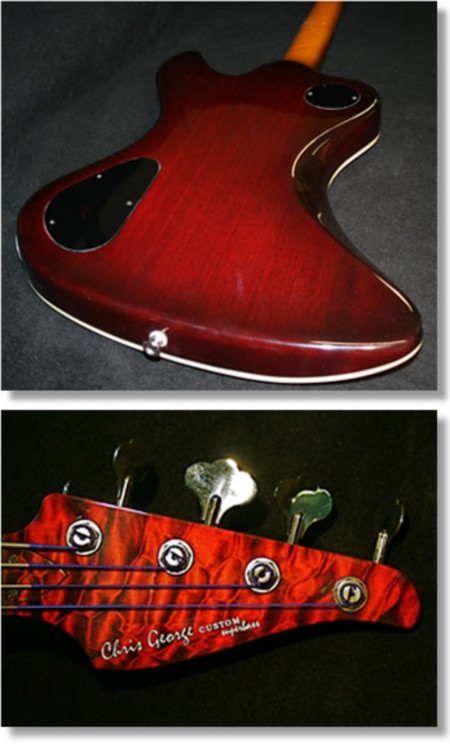
So there we have it - the 'Superbass'. This title was added to the headstock logo at Nina's request.
The range of tones is obviously wide considering this is not an active bass. A set of flatwound strings add a lot of good old fashioned 'fatness' and no squeaky finger noise. Yes it is still a little top heavy but with this design it was always going to be, but it plays wonderfully and sounds superb and yes, it looks cool.
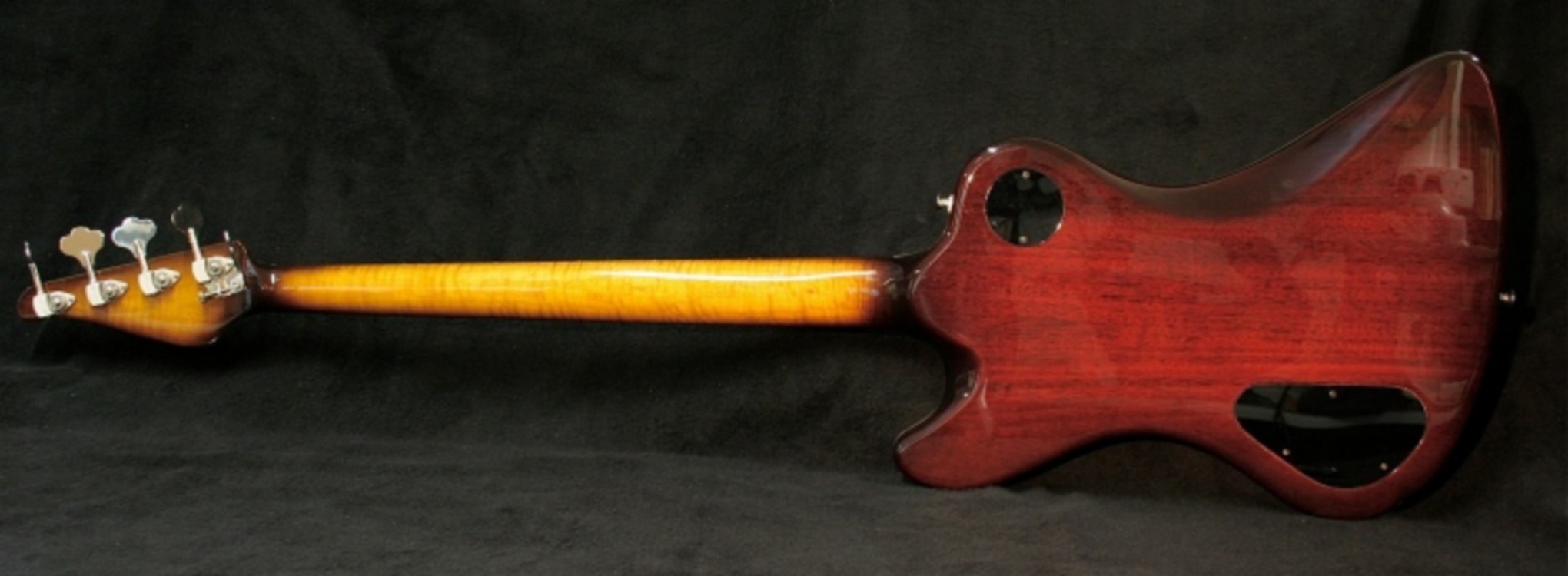
2011 Starmaster Electric
...or a guitar called Colin?
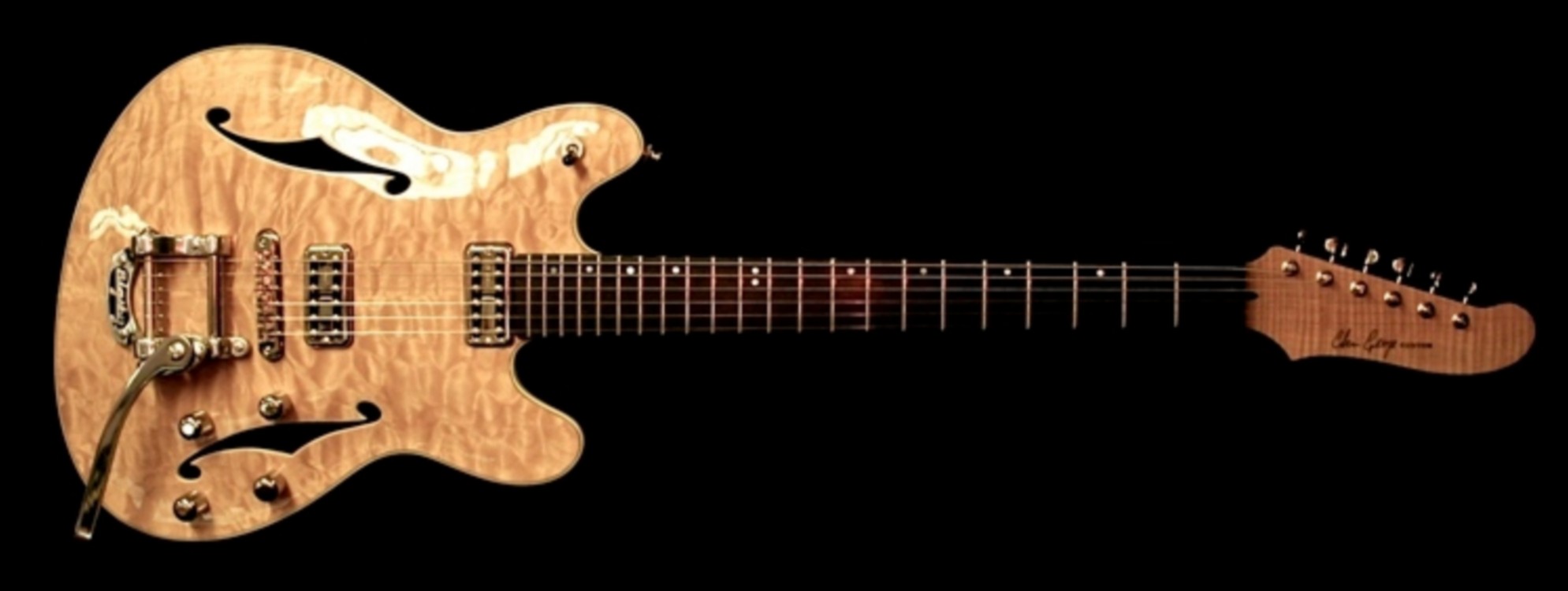
No of course it's not really called Colin, read on.
About a year and a half ago, I received an email from a guy who played in a "Killers" tribute band and he enquired about me building a copy of a Fender Starcaster. This was a semi acoustic that Fender brought out in the mid 70's through to the early 80's to compete with the Gibson 335.
I can remember travelling to London with some friends in the mid 70's to do the trawl of the London music shops - Charing Cross Road, Denmark Street etc. and asking a rather reluctant shop assistant if we could 'have a go' on the black Starcaster in the window. I loved it and watched as Mr Reluctant polished off our greasy finger marks and put it back on display.
Anyway I priced up a build for Mr Killers but suspected that he could get a real one for similar money as I heard no more from him. A few months down the line, I had a similar request from Colin in Glasgow and we chatted via the phone on specs. I soon realised that he knew a lot about guitars etc. and settled on making a guitar with the shape of a Starcaster but scaled down in size. As is often the case, when I need inspiration or an original guitar to take details from, I went to Old Hat Guitars, an emporium of vintage and rare guitars and amps.
They had just sold one to another Colin, (Colin 2) and gave me his phone number and I duly chased it up and arranged to visit with camera, ruler, paper etc. Colin 2 was most accommodating and allowed me to photograph, draw and measure his Starcaster. The first thing that struck me was just how big the guitar was, far far larger than the one in my memory. I rather suspect it was as large as a 335 - not that surprising I suppose. With all details taken I then produced four scaled outlines of the guitar as Colin 1 wanted a smaller guitar and he decided that a 90% sized one was for him.
The original Starcaster was built with a laminated contoured top and back but we decided to do a carved top with hollowed out mahogany back and sides. Colin chose some gorgeous quilted maple and soon the build was on. Hardware was to be two TV Jones pickups, a Classic Plus bridge and a Powertron neck, two volumes and two tones with three way toggle set on the top rather than bottom horn, a TonePros bridge and a B5 Bigsby.
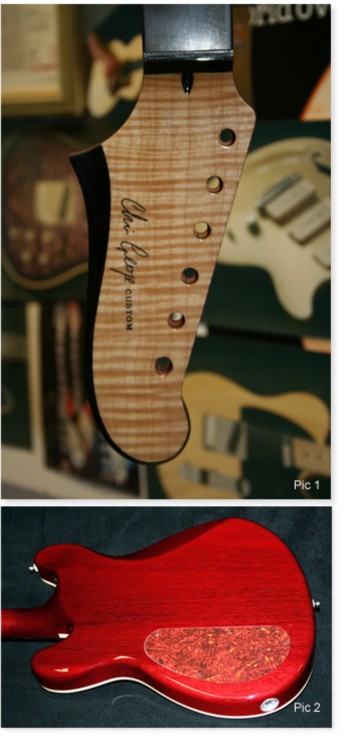
It was only when I thought about it that I realised the B5 wasn't suitable for a carved top, so we swapped this for the B7 tailpiece unit. Then I found that this wouldn't work either as it was too long for the scaled down body and with the offset body shape it would not fit the end of the guitar. So......... it was back to the B5 and some careful thinking about the carve on the top.
Bodywise the build was now very consistent with my other hollowbody builds and went smoothly. The Fender "f" holes were dropped in favour of my, 'Vox meets Thinline' holes, that appeared a short while ago (knew they would). Scaling down the body size brought about a slight change to the headstock shape as the tuner hole spacing needed to be standard to fit the Gotoh self locking and height adjustable tuners. To me it has shades of a Gibby Explorer about it but we did keep the original's concave chamfer. (PIC 1)
I'm now really pleased that I couldn't talk Colin into one of my 'bursts' on the top and my, did I try. It has a nice 'honey glow' that is reminiscent of a Rickenbacker Mapleglow finish and I love it. The back, sides and neck were finished in cherry lacquer, all gloss apart from the back of the neck which had a satin finish.(PIC 2)
I did take it to meet it's dad and they seemed to get on well together.(see below) Many thanks to Colin 2 and of course Colin for the commission.
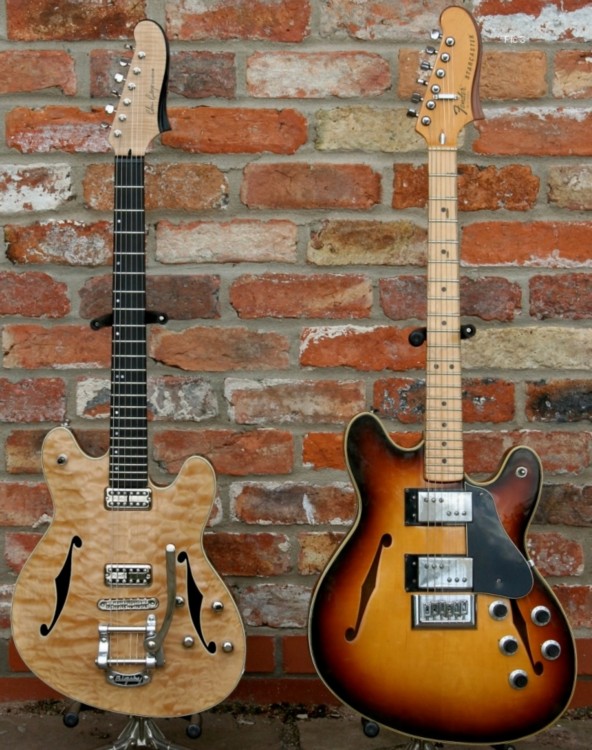
2011 33G Semi P90 electric
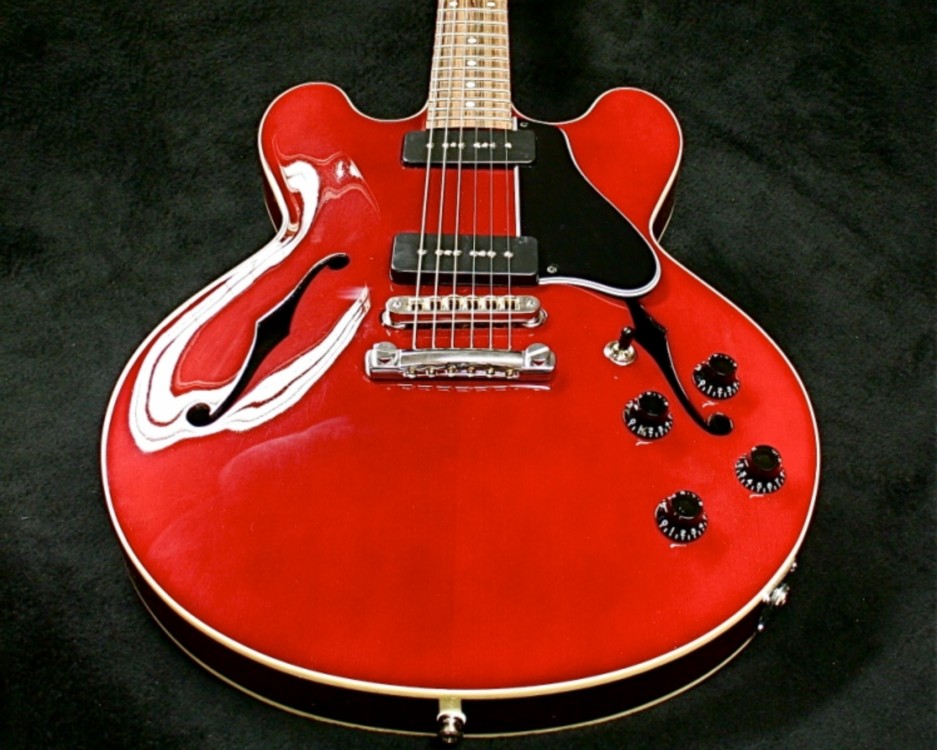
I'm a little wary of writing about this build as it is for one of my customers, who for a better description, can only be called a 'complete guitar nut'. He has had a number of guitars built by me. I dare not say how many, in case his wife should discover my site, and I'm held responsible for the divorce or worse.
Suffice it to say that this build differs from all of Steve's others. He is Tele man at heart so it came as a bit of a shock when he muted his next build would be a small 335-ish hollowbody. I was pleased, as I had wanted to build a similar style of guitar for some time, more so now that I had built 'my' Hollowbody based on my Custom Classic shape. Steve's spec was remarkably similar to the afore mentioned hollowbody in that it was mahogany set neck, with a carved spruce top with piezo bridge and mag pickups, unfortunately no Bigsby (boo hoo). Steve chose Lollar Low Wind P90s, whereas the Hollowbody sported three Lollar Charlie Christian pickups. Again the LR Baggs piezo bridge was set into the top to give a lower, more Fendery feel than a Gibby. Scale length was Gibby too.
I played about with the sizing until we settled on a lower bout of 15 inches, and after a few tweaks, a pattern was made.
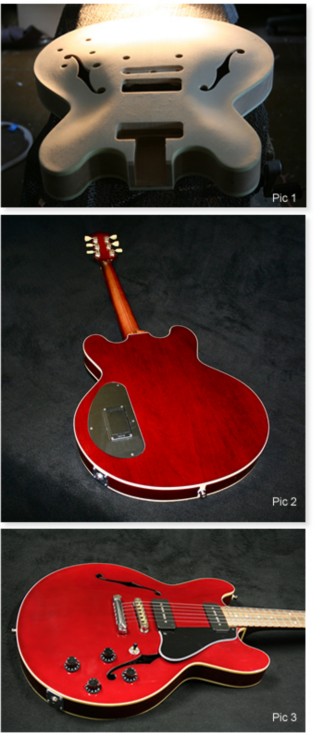
The top was hand carved out of European spruce, although at one time it was going to be mahogany. Two unbound 'f' holes were added (or should that be subtracted) and once the outside was carved the inside was hollowed out, not as thin as in an archtop jazzer but about 1/4" thick apart from the bridge and neck blocks. (PIC 1) The body was routed out only leaving the back, walls and matching bridge and neck blocks. The neck was my now, usual triple spliced mahogany with carbon fibre bars and two way truss rod with a slight vintage vee profile. As Steve wanted a double bound body, it wasn't my heeless design but rather a traditional heel with a macassa ebony heelcap to match the unbound fingerboard. Steve wanted a red wine, rather than cherry finish to the body, the neck having a slight hint of tobacco and the back of the neck was satin, whereas all other was nitro gloss.(PIC 2)
Control wise it was one tone, one volume and selector toggle switch for the p90s and one volume for the piezo bridge. To keep things looking 'right', the miniature LR Baggs mags/both/ piezo toggle switch was replaced with a three way rotary one.
Battery access for the piezo preamp was housed on the rear control cavity plate. As usual the inside control area was heavily copper foil screened.
The end result bought nice comments from folk who wandered into the workshop. I must say I was chuffed with the colour but only got one chance to play it in earnest at a 'Rocket' rehearsal. The LR Baggs bridge and preamp always amazes me with it's sound. The Low Wind Lollars are more gentle than a standard P90, more towards Fender than Gibson to my ears but the real pleasure is having piezo and mags on together into two amps and blending the mags into the piezo mix via a foot volume control but then I've always been an acoustic folky with rock ambitions at heart. (PIC 3)
So with this build complete Steve has told me not to answer any emails or accept any calls from him. It's his 'last' guitar........pull the other one Steve, see you soon.
2011 Vox type New Escort
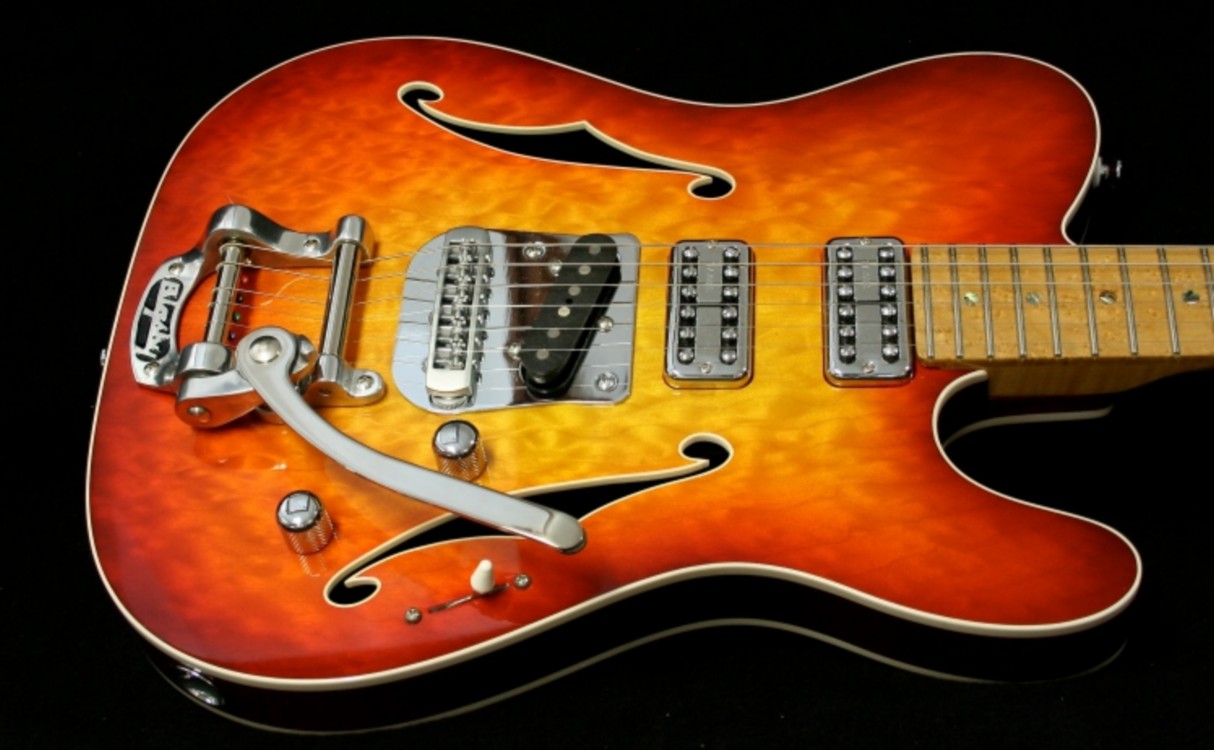
A while ago I'd built a replica of a Vox Consort for a customer and now my customer Ian, requested a 'New Vox Escort'. Originally the Escort was a two pickup version of the Consort so, here we go I thought'. Wrong! The 'New Escort was in fact a copy of a Telecaster body with a Vox Phantom neck. So far so good.
Ian, however wanted a 'Hollow body" or 'Thinline' tele type body with the Phantom neck. No probs. The spec. would be, swamp ash body, with a quilted maple top. The "f" holes were a cross between a Vox tear drop(reversed) and the Fender thinline - a design which I'm rather pleased with and one that will reappear shortly I'm sure. These were bound in white celluloid to match the double bound body.
The bolt-on neck was to be flamed maple with a birdseye board and the neck to body pocket would be shaved for upper fret access.
Hardware had to include a Bigsby vibrato and Gotoh locking, height adjustable tuners together with a Schaller roller bridge. For the pickups Ian chose two TV Jones Classic pickups and a Lollar '52T bridge pickup.
Switching was via a Strat type 5 way, with a push pull switch on the single tone control, giving 7 pickup switching options. Although there is a lot going on on the front of the guitar, the 'drop in' TV Jones pickups helped it to look tidy.
Ian wanted a sunburst finish of just reds and yellows, rather than the traditional 3 tone burst (although in fact it was made up of two yellows, one amber and a cherry red-but don't tell him.)
Because the body was double bound, the front was sprayed first with sides and back masked off. Then the front bindings and "F" hole scraped clean. Front and sides were then masked and the back sprayed and bindings scraped. Finally the front and back were masked and the sides sprayed - yes a long drawn out process but one that ensures that the result is very clean and tidy.At first I was rather dubious of using pure white bindings, favouring a more 'aged' coloured cream but the results were superb - well done Ian, good choice.
The finished guitar is a great looker and the combination of pickups works very well. The TV Jones takes it out of Tele territory and with the Bigsby, you sort of know where it's heading tonally. Nice one Ian, I look forward to your next!

2011 Les Dawson single cut electric
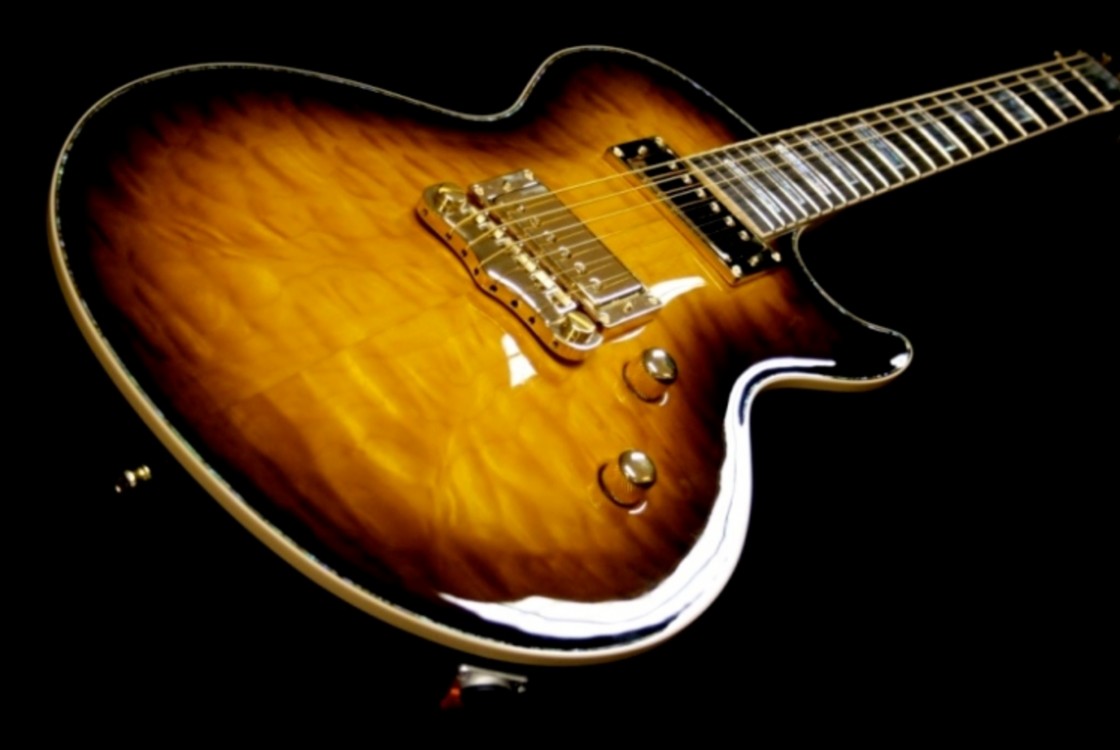
I know it's not really funny but always when asked to make a Les Paul type guitar I'd refer it it as a 'Les Dawson'. So when Keith, a previous customer with a set neck 'T' type and a set neck 'S' type under his belt, came to me and commissioned a Les 'P' type single cut electric, I referred to it in all correspondence as the 'Les Dawson'.
The spec. for this build was very high. Indeed the top (5A quilted maple) had been put aside for a special for myself - it was so good, but as Keith fell for it, it was his. Keith's previous two builds had common features, locking Neutric jack sockets, LSR Roller nuts, Steinberger tuners, and necks spec'ed to a few thou. This build however was to supersede the other two. All hardware, including the pickup rings, were to be gold plated, the ebony fingerboard adorned with abalone and Moth of Pearl rectangular inlays, and to cap it all the body and headstock would be bound with abalone and cream bindings. I have been known to be a bit 'Bling' with my builds but even to me, this seemed rather like a 'Bling Fest'
However with those wise old words, "The customer is always right", whispering in my ears, we set off on the build.
On the hardware side I must mention the nice guys at Sperzel machines. They made up a custom set with the key barrels in differing lengths, so that when fitted they would give a straight string pull on a typical 'Gibby' headstock, gold plated of course.
The body was mahogany with a 'belly cut' and weight reduced but not chambered. The set neck was to follow my heeless design. It was to have an unbound ebony fingerboard and bound ebony headfacing. Pickups were two Seymour Duncan JBs and there was to be a single volume and a single tone control with a push/push on the tone control to engage each pick up separately (no 'both pickups on' option, "I never use both humbuckers together", end quote).
The basic build was quite straight forward, one piece mahogany body, and a triple laminated mahogany neck with two carbon fibre rods and two way adjustable truss rod. The carbon fibre is used to stiffen the neck as it rather long without the more usual Gibby type heel. The quilted top was given a slightly exaggerated carve and because the pickup surrounds were gold plated metal, the top carve had to be made to match (there is little or no 'give' in the metal as there is in plastic surrounds).
In keeping with the 'Gold' look we decided to use gold fretwire - no, not real gold but Jescar 'Evo' wire which is gold coloured. I even went as far as fitting Optima gold plated strings - well if they're good enough for Brian May.......
The inlaid abalone bindings round the body and headstock took a lot of work. They were was made up of fine line black/abalone/fine line black/cream plastic, but all turned out just fine. Rather fine actually.
The maple top was triple stained and grain enhanced before being lacquered with an 'edge burst' and the mahogany body and neck were given my typical tobacco burst.
Now this is where I got my comeuppance, (my petard in fact,) I had put a gold 'CUSTOM' transfer on the trussrod cover, in keeping with the Les Paul vibe, and was feeling rather pleased with myself until Keith emailed to say he would like the cover to have a 'Les Dawson' logo on it! No it wasn't a joke. So I thought I'd go one better and asked my transfer maker, Glen, (plankspanker@blueyonder.co.uk) if he could do a 'Les Dawson' but in the 'Les Paul' font, and he did bless him.
So there it was, a genuine Les Dawson, and me dangling from the end of my own petard.
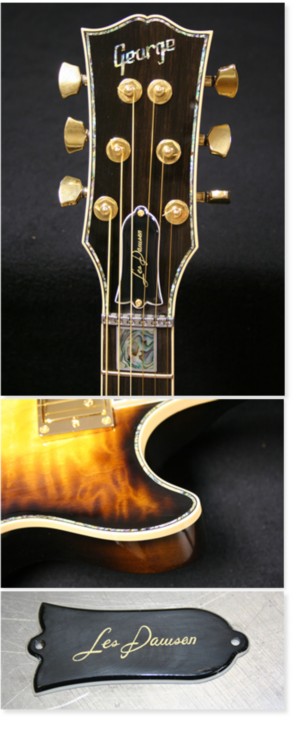
2011 Double cut Koa Drop top electric
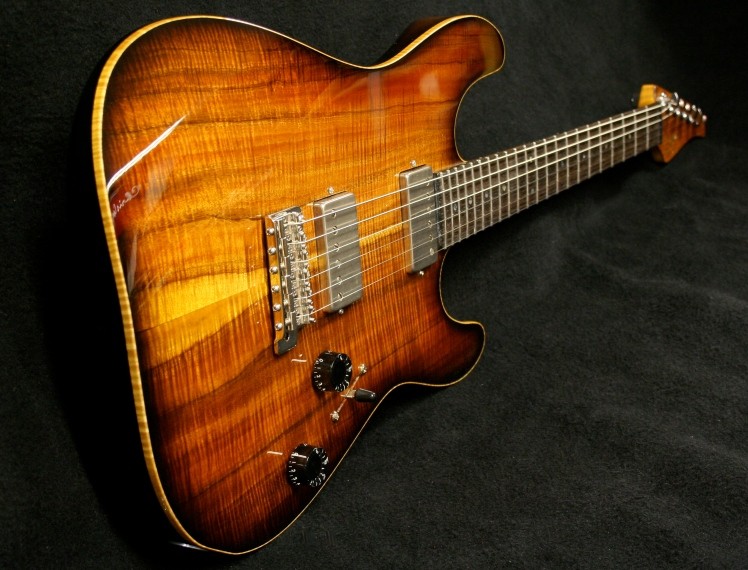
Over the past few years I've carried out work for 'The Doctor' on some of his high end American boutique guitars and so was rather flattered that he wanted me to build him a guitar. Mind you, it had varied from an acoustic to an electric, so I wasn't holding my breath. Finally it was decided that it would be double a cutaway, twin humbucker electric. No problem I thought - little did I know.
The Doctor had very definite ideas. It was to be an "S" type but 95% size and with thinner horns. It would have a chambered mahogany body with a Koa drop top, exaggerated contours and a flamed maple heeless set neck, compound radius board and stainless steel frets. Hardware was to be a pair of Lollar Imperial Humbuckers, a Callaham Vintage trem, Steinberger gearless tuners and a Tremol-No locking tremolo device, one tone and one volume control (both are numbered 1 to 11- "it's one louder innit!") oh and some trick switching via a 5 way pickup selector.
I'd made a few set neck "S" types before so first port of call was to scale one down via a very clever photocopier and make a drawing of what goes where. As the neck was to have a headfacing in Koa (PIC No 2) we decided to have the truss rod adjustment at the fingerboard end rather like Music Man, using a spoked-wheel adjuster. I made a few mock ups with the adjuster set into the fingerboard recess (Music Man) but The Doctor liked my solution more (PIC. No 3). We had decided not to have pickup surrounds and to mount the Lollars in the Koa top. They would be accessed from the front of the guitar but - and it's a big BUT - with only the pickup covers showing and not with the ugly mounting legs as on most other direct mounted humbucker guitars. I had done this before and although it's not that difficult, it does make the build process much more protracted. However, the end result is a very clean, uncluttered look that we both liked. The Koa that was chosen was quite stunning, so much so that I had bought two sets, thinking that I would use one for myself one day but The Doctor has laid plans for a matching future build.
So with the mahogany body shaped and chambered and the forearm chamfer radiussed, the 6mm Koa top was pre-bent to fit, but not before the pickup holes and trem routing had been carried out. Remembering that the pickups had to be dropped in from the top, the mahogany body was routed so that the pickups could be slid in and pulled back into position - particularly tricky with the neck pickup as the long neck tenon extended to the back of the pickup cavity. This still made the adding of the mounting springs quite difficult but nothing that a skilled luthier couldn't do (If only I could find one).
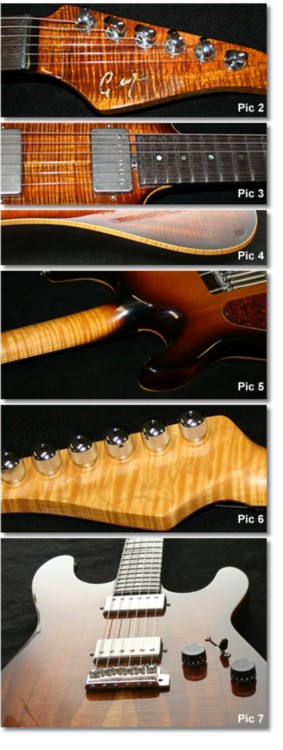 So, assured that the pickups could be mounted, the Koa top was glued to the mahogany body. Originally the edge of the Koa was to be left unstained to look like binding (a la PRS) but the Koa was so stunning that we didn't want to put a lot of colour over it and yet we wanted some form of contrasting binding. This is always where a guitar builder opens his big mouth and suggests something that is very time consuming and difficult to do. Enter Big Mouth, "It would look good with flamed maple bindings". Not the easiest of tasks with the forearm chamfer and the rather tight radii on the horns but the result was well worth the blood, sweat and tears. (PIC No 4) With the bindings on, the neck was glued in using a long tenon joint and blended into the body. (PIC. No 5)
So, assured that the pickups could be mounted, the Koa top was glued to the mahogany body. Originally the edge of the Koa was to be left unstained to look like binding (a la PRS) but the Koa was so stunning that we didn't want to put a lot of colour over it and yet we wanted some form of contrasting binding. This is always where a guitar builder opens his big mouth and suggests something that is very time consuming and difficult to do. Enter Big Mouth, "It would look good with flamed maple bindings". Not the easiest of tasks with the forearm chamfer and the rather tight radii on the horns but the result was well worth the blood, sweat and tears. (PIC No 4) With the bindings on, the neck was glued in using a long tenon joint and blended into the body. (PIC. No 5)
The guitar was finished in nitrocellulose with a slight edge burst on the front and tobacco burst to back and sides. The neck very slightly stained to show the flame off. (PIC. No 6)
The result is one of my favourite guitars. It is one I would gladly keep for myself with very little modification from The Doctor's spec. (Let's be picky - a slightly higher action perhaps?) But far more importantly 'The Man' was genuinely over the moon. Just what the doctor ordered then! (Sorry about that) (PICS 7, 8, 9)
Spec.
- Chambered mahogany body with highly figured koa top and flamed maple bindings
- Flamed maple set neck with koa headfacing. Two carbon fibre bars and two way truss rod
- Macassar ebony fingerboard with 11/14" compound radius. Stainless steel medium jumbo fretwire, abalone dot markers
- Lollar Imperial pickups with aged nickel covers
- Callaham Vintage S Trem with Tremel-No locking device
- Steinberger gearless tuners
- 5 way superswitch with custom wiring (anoraks see below) One volume and one tone control
- Edge mounted Electro socket and Dunlop strap buttons
- Nitro cellulose finish
Anoraks only-wiring details
Switch pos.1 Bridge pickup with tone
pos.2 Neck front coil+Bridge front coil, reverse phase with tone bypassed
pos.3 Neck and Bridge pickup with tone control
pos.4 Neck back coil+ Bridge back coil, reverse phase with tone bypassed
pos.5 Neck pickup with tone
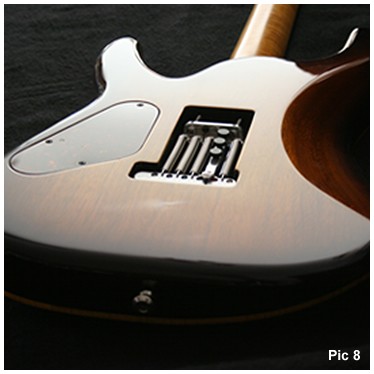
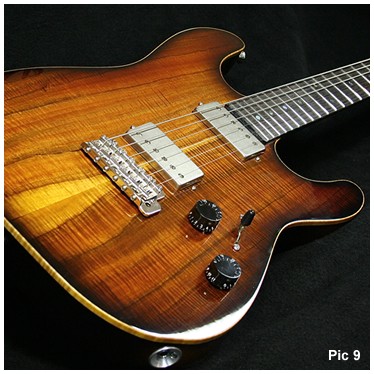
Errata - Apologies to MusicMan for my error. Musicman guitars have the adjuster at the end, and not set into the fingerboard as I stated. (exactly like mine in this build) Where I got the notion that they set theirs into the board I have no idea, I'll put it down to too much lacquer fumes!
2010 Fender Telecaster Variax conversion
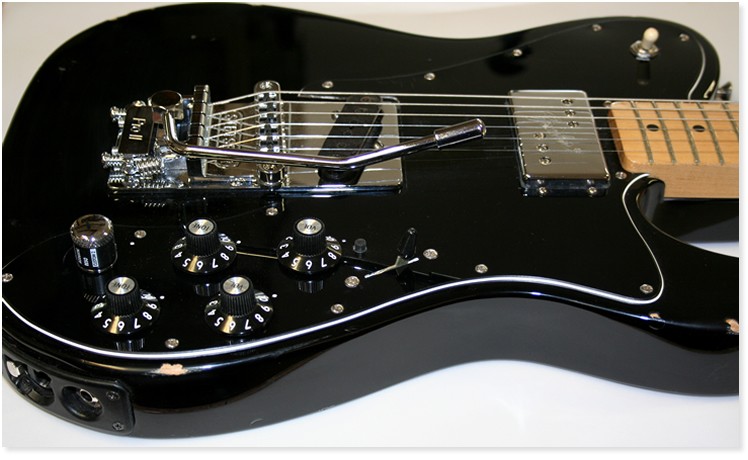
This was, strictly speaking, not a build but a conversion of a standard Telecaster into a Tele/Variax hybrid. I do get a number of enquiries of this nature and often my build schedule doesn't allow me to accept this work, however now and again I take it on.
What attracted to me to this one was that Chris, who is 'Keef' in a Stones tribute band (The Bog Rolling Stones), wanted a Stetsbar vibrato fitted and he wanted to be able to switch between the fitted mag pickups and the Variax models, using the same output jack socket. This was different to custom "T" types I had done previously as the customers wanted two outputs, so I thought I'd rather like to take it on.
The guitar was a Mexican Fender 72 Custom Reissue Telecaster, a bit road worn but in fine fettle. I advised Chris to chase after a 500 series Variax as a doner, rather than the 300/600, as there is much more flexibility in the control positioning and he wanted all controls to fit on the original pickguard.
The added beauty of the Stetsbar is that it uses the original bridge screw holes so you know exactly where it is going. It was ordered as a 'special' as the bridge needed to be machined to take Graph Tech 'Ghost' piezo saddles to power the Vx electronics. Once all the parts were gathered, the conversion went smoothly. As with any custom job or modification, it all comes down to planning. The positioning of the Vx output jack was carefully considered, as it has to closely match the guitar's edge contour and as it protrudes into the guitar a fair way it could interfer with the 'fixed' positions of the pickguard mounted control layout.
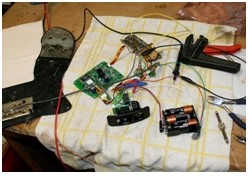
I spent some time experimenting with the switching arrangements and decided to use a small push/push switch to select Vx/mags. Only the switch tip was to be visible, no screws, no bezel, very neat and it worked!
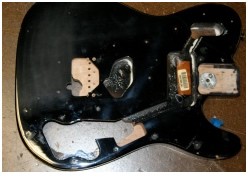
The top needed to be routed to give space for the original Variax ribbon connector underneath the Stetsbar base plate and for the Vx 5 way switch and volume control. The back routs follow the standard 500 pattern.
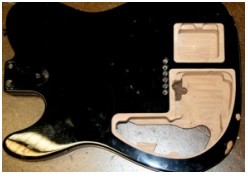
Routing the back could have had a problem with the finish chipping but all went well and even if I do say so myself, it was a pretty neat job.
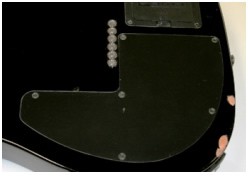
All electronic cavities and the pickguard were copper foil screened (miles better than paint) and the Vx electronics installed. The fixing of the push/push switch required a bit of thought and was eventually mounted on a small aluminium bracket attached to the large rear control cover.
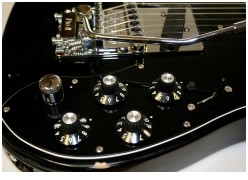
Here is the finished product with the control cavity covers in place.
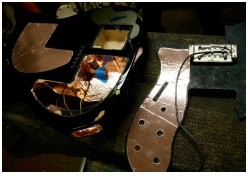
We decided to keep the original top shoulder pickup selector for the magnetic pickups and to wire them to a single volume and tone pot. That would leave two existing holes in the pickguard to take two of the three Vx controls. A third hole (complete with a white dot marker) was added to take the Vx volume pot, spaced to match the originals. So the top row from left to right are Vx model, Vx tone and Vx vol. The Vx 5 way was positioned rather like a Strat with the push/push just above it. Bottom row, mag tone and mag vol.
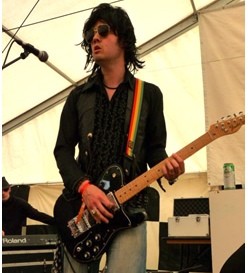
With the neck on and all strung up it was sent to Chris who gave it a good road test on a gig at the Isle of White Festival.
His Les Paul was poorly (Les Poorly?) and so he completed the gig solely with Mr Televax.
Job done as they say!
2010 Koa acoustic and friends
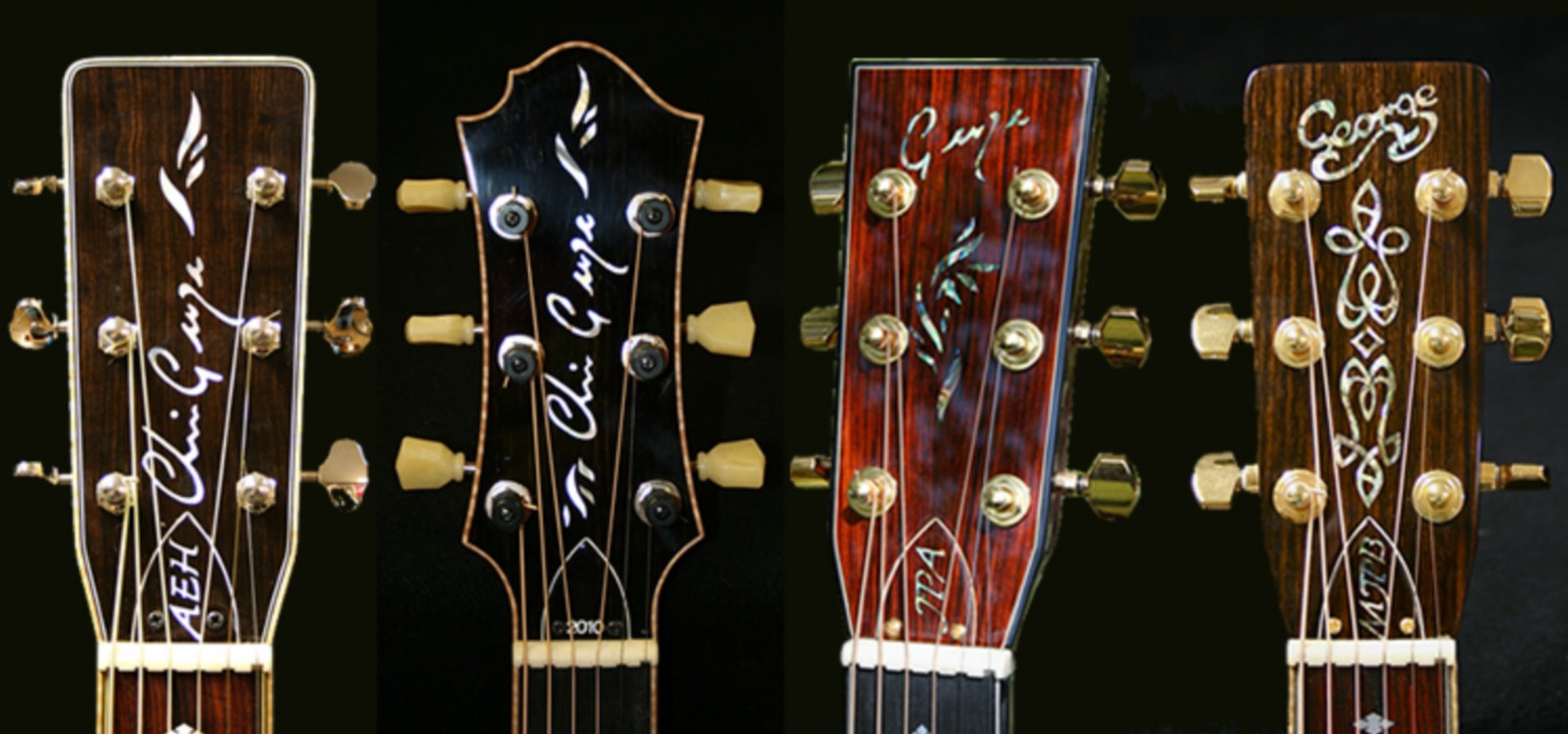
This is not a true featured build in that it includes four acoustics guitars built in succession. All were identical in dimensions but different in detail. It started late 2009 when Tony got in touch and commissioned an OM size guitar in Koa/Sitka with a three piece back of Koa and quilted maple.
It was very similar to my personal OM guitar featured previously. Tony and I had been to college together in the dark ages and although we hadn't kept in touch at all we were soon reminiscing about our old college folk club days.
With the spec finalised and Tony being banished from the workshop, his wife Lesley agreed the price, as she was buying it for him - lucky bloke I thought.
The second was for Paul, a previous customer who chose Cocobolo back and sides with a Sitka top. Paul gigs regularly and so needed a pickup system included. I had just retro fitted a Shadow Dual Sound system into my guitar and after trying it, Paul decided to have the same.
Third along the queue was Mick, again a previous customer and ex member of the South Chingford Rockets. His spec was Sitka top with Indian rosewood back and sides and this one was to be purely acoustic. The headstock inlay was a copy of the inlay I had done on his nylon string cutaway some years ago, jokingly titled 'Tattershall Celtic'.
Finally the fourth one was for Peter who manages my web site. Peter decided that 'less was more' and went for Tazmanian Blackwood (very similar to Koa) back and sides with a Kamode spruce top. The top was from a split billet (rather than sawn) of top end wood.
Peter had bought his favourite neck, attached to a guitar! and measurements were taken. Headstock and fingerboard inlays were to be more Gibsonesque than the previous guitars and rather followed my electric 'Custom Classic' pattern. Again this was to have the Shadow Dual Sound system.
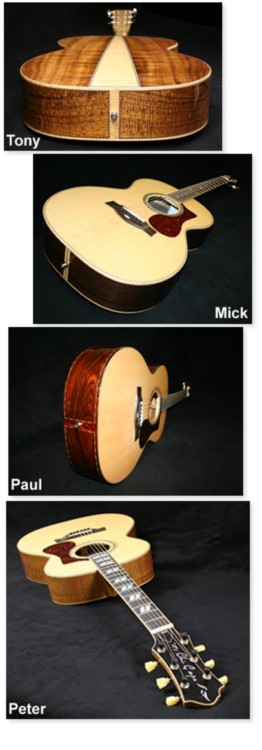
So four guitars, same shape, same size, same scale lengths all fitted with bolt on necks and a bridge truss system, same scalloped bracing but different woods and visual appointments. So how do they sound? Well the honest answer is very similar but each slightly different.
All quite punchy, can be strummed or picked and nicely balanced. The two rosewood ones (Mick's and Paul's) have perhaps a little more middle. But all will change with playing and time. Do I have a favourite?
Yes actually I do but no, I'm not saying. Well, would you?
[Ed] Yes, I would - obvious really! [Ed]
2009 Triple Charlie Christian pickup Hollowbody
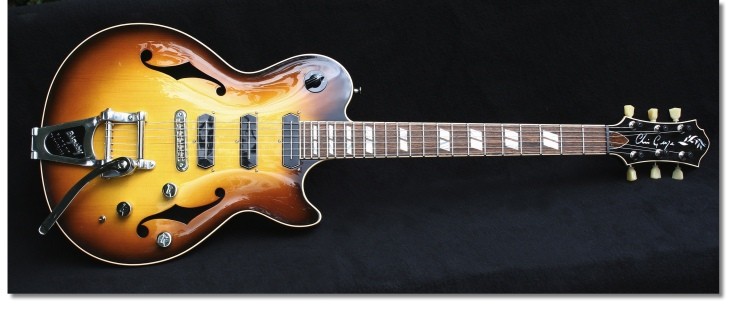
This build actually started, in my head at least, shortly after my first Variax equipped guitar appeared in Guitarist magazine in 2004. I received an enquiry about the guitar from a guy who was into Gretsch guitars, and from the pics in the mag, assumed that mine was of similar hollow body construction whereas, it was in fact a chambered body.
We met to discuss the possibility of a custom guitar but nothing came of it. Then again in 2007, I discussed the possibility of building a hollowbody with another guy, who was into the same type of guitar. Again it remained just an enquiry. (Interestingly, both were into Jerry Reed style of playing, coincidence or what?) but it had sowed the seeds for me to design and build a hollow body electric. I 'booked' some time in my build schedule, the only way it was going to get done, and in July 2009 I started.
As I have said previously in a 'featured build', one of the most difficult, and exciting things, about building a one off for no one in particular is deciding on the details. I had, however, been working on a fair few old Hofner, Framus and Kay guitars from the 60's and the idea of a 'vintage vibe' began to materialise. I had also recently built a number of custom guitars where the customers had supplied Lollar pickups. One in particular stood out and that was the Lollar "Charlie Christian" model. It was supplied to me to use in a custom thinline "T" type. So pickup type sorted, and with the guys who had first inspired this build in mind, I decided to add a Bigsby vibrato for the wobble factor and because they do give a guitar a certain 'vibe'. "Guitar jewellery" I think is the term. I had also recently fitted a LR Baggs piezo bridge and preamp to a couple of my customs and wondered how a piezo bridge would fair with a Bigsby. So that, together with a set of TonePros locking 'Kluson" tuners, was the hardware spec. sorted.
Initially the guitar was to be a copy of my 'Custom Classic' shape but this changed to a 7% increase in size making the lower bout 14.5 inches and I increased the body depth at the rim from 1.75 to 2 inches. In keeping with a "Hofner/Framus" vibe, I decided that the top would be spruce rather than my usual over the top figured maple and I even forced myself to leave the two "f" holes unbound. "Keep it simple" was to be my mantra! The body was one piece mahogany, routed out, apart from a bridge and vibrato "U" shaped support section, and a neck block to take a long neck tenon. This long tenon proved to complicate the build more than somewhat as you will see.
The neck was triple spliced mahogany with carbon fibre reinforcement bars and a two way adjustable rod. Despite my mantra, the fingerboard was highly figured Bocote with split block pearl markers. The neck to body join was my 'heeless' design, going a little against the vintage vibe but oh so usable at the dusty end of the fretboard. The body was single bound with matching fingerboard and headstock.
The build went smoothly. The spruce top was beautiful to carve and far easier than my usual maples and the carve was slightly more pronounced than my custom classic. Once the outside was shaped it was then carved on the inside much like an archtop but thicker, leaving only the bridge and neckblock areas untouched. The hexagonal holes for the pickups were cut out together with the 'f' holes. It did take some effort not to bind them but my mantra won through. The LR Baggs bridge was recessed into the top to slightly lower the string angle to the vibrato and to hide the 6 wires from the piezo saddles but also to suit my playing style. I'm more of a Strat than a Les Paul player and I favour the lower bridge. .
I had a set of Lollar CCs made, the middle being RWRP, and this was where the fun really began. The CCs cannot be dropped in from the top, like humbuckers or P90s, as the base is larger than the pickup's top plate and there are no pickup surrounds to cover the mounting plate. With a hollow body they can be dropped sideways through the hexagonal pickup holes in the top and then straightened up and brought back up through the top.This is fiddly but doable, as long as you have glued some rubber mounting tube to the base plate instead of using springs. Alternatively they can be slid in through the rear control cavity. This works fine for the middle and the bridge pickups but the neck position was made difficult with the long neck tenon and neck block not allowing enough space for the pickup to drop down and be straightened. The problem was finally solved by ramping the tenon on the base side and sliding this pickup in through the control cavity and up into the pickup selector cavity and finally up through the spruce top. Needless to say a number of "dry runs" took place before the top and body were glued together. Even then it proved to be a long slow tricky job, once the guitar was finished. The inside areas of the hollow body were sealed and copper foil screened at this stage, as the pickups are single coil and not humbuckers. However once top and body were together, the build proceeded quickly.
I had decided to use a 5 position rotary pickup selector switch with a chicken head knob for the Lollars, in keeping with the vibe, but instead of the obvious Strat type combinations, I opted for bridge only, bridge and middle, bridge and neck, middle and neck and neck only- the bridge and neck option being my favourite sound from a Tele. I wanted the controls to be simple with one volume and one tone control for the Lollars but I did equip the tone control with a push/push switch to change the capacitor value from 0.015 to 0.047. The volume control also had a switch inside the control cavity, which could switch in or out a treble bleed capacitor as I wasn't sure which I would eventually prefer. The Baggs had a volume control for use when outputting in stereo and this would act as a pan control in mono mode. A discrete switch on the back of the control plate will select mono/stereo mode.
The guitar was finished in gloss nitro tobacco burst but with the back of the neck in a satin finish, again influenced by a recent customer.
I'm really pleased with the overall vibe of the guitar. The Baggs and Bigsby work perfectly. (I did wonder whether it would sound a bit like a chainsaw, but there is enough movement by the bridge to prevent 'sawing' over the saddles) and the Lollars are wonderful. The natural resonance is pleasing. It doesn't have the 'boxy' sound when played unamplified, that you can get with some semis but that's down to the thicker than semi top and back. I was a little surprized at the weight, 8 lbs, but the Lollars on their own add just over one lb and the Bigsby and the gorgeous 'Gretsch' knobs a further one pound. Thank goodness I hadn't bound the 'f' holes!
I plan to use a stereo lead into two amps, one acoustic, one electric, to get the best out of it, rather than mixing it into one amp. Piezos never sound good to my ears on an amp set up for mag pickups. So far it has only been played at band rehearsal but even the drummer noticed. Must be better than I thought!
So finally my thanks go to those who sowed the seeds-George, Peter, Paul, Steve and Warren, you may know who you are!
For the real anoraks:-
Single cut mahogany hollowbody with single bound carved spruce top
Triple spliced mahogany neck with Bocote fingerboard with split pearl markers
Figured ebony head facing with pearl inlay. Bocote inset truss rod cover
Scale length 24.75"
F/board Radius: 10 to 12 inch (conical) Medium jumbo frets
Nut width: 42mm GraphTech
Depth of neck at 1st fret: 21.5mm
Depth of neck at 11th fret: 23.5 mm
Max body width: 14.5"
Max body depth: 64mm
Depth at rim: 50mm
Three Lollar 'Charlie Christian' pickups
LR Baggs T Bridge and Preamp
Bigsby B7 Vibrato
TonePros locking Kluson tuners
'Gretsch' style metal knobs
5 way chicken-head pickup selector
Dunlop locking strap buttons
Weight 8 lbs
Nitro cellulose tobacco burst gloss to body, satin to back of neck
2009 Vox type double cut Consort

The really nice thing about being a custom guitar builder is you never know what's round the corner. A while ago I took a call from a guy who wanted a copy of a Vox Consort. Now I knew about Vox Phantoms, Teardrops , Mandolas and Organ guitars of the 60's but I'd never heard of a Consort. It was apparently the three pickup version of the two pickup Vox Escort, again a guitar I'd never heard of. Not to worry I have a picture of one said Ian and so we arranged a visit to my workshop to discuss the possibility of a custom build.
Ian duly arrived with an old 60's Vox handout held together with yellowing sellotape. It showed a five centimetre tall, grainy shot of a heavily Fender Strat/Jaguar influenced guitar. Not the prettiest beast I had ever seen and sporting a headstock that looked as though designed by Salvador Dali.
It was very apparent whilst chatting with Ian that he had something of an encyclopaedic knowledge of guitars ( It turned out that he actually made parts for the 'resotube' trems on the 60's Burns guitars) and that he was passionate about the Consort.
The spec. for the proposed guitar was a bolt on neck, three pickup guitar with trem. Switching was via three pickup selector sliders with two phase reversal switches for pickups one and three. There was also a Strat style master volume and two tone controls and an active mid boost circuit. With this agreed, we arranged another meeting before work started.
My first port of call was to trawl through all of my guitar books- no mention or picture of a Vox Consort or Escort anywhere. I tried Google and came up with amps and organs bearing the name, a line or two about the first series Consort (1961/63) and second series (1963/65) but nothing more. I did get a picture of a second series model sent to me by a very helpful American firm called 'Phantom Guitar Works', unfortunately the shot wasn't square on and so it was somewhat distorted. But together with it and some scale measuring and a good enlarging photocopier, I finally came up with a version which I was happy with.
Ian was also happy with the shape and suggested a slight mod to my pickguard outline and it was then down to choosing woods and hardware.
Ian chose Alder for the body and some very nice flamed maple for the neck, (which was to have a Phantom 'paddle style' headstock rather than the original.) Fingerboard was rosewood; all very Fender. The nearest to an original trem. was a Fender Mustang unit and the pickups, covers and aluminium knobs would be supplied by the friendly Phantom Guitar Works (the pickup covers were square ended unlike modern single coils but accepted Fender 57/62 pickups). The only outstanding item was a mid-range boost tone control that Ian assured me the original Vox did have. This I was going to have to work on. The body colour decided upon was a pale blue, again a very Fender DuPont colour. Ian had bought his favourite guitar neck with him (attached to a Gibson SG) and I took measurements and profiles. So all this decided Ian went on his way and I said I'd keep in touch when the build started.
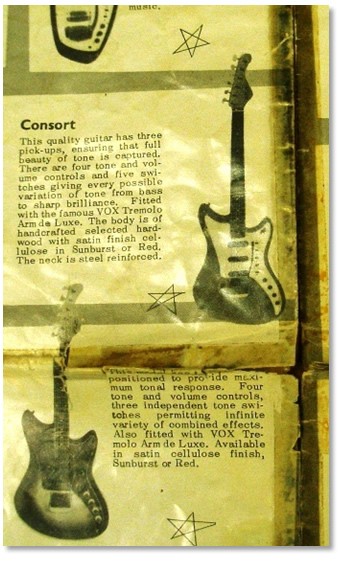
With a one off custom build, success is all in the planning. I like to get all the hardware together, every piece and every screw so that any layout can be as accurate as possible. The only missing part was the mid boost circuit. I made templates for the body and pickguard and routing templates for the trem, pickup and control cavities and set to work on the build.
I tried searching for mid boost circuits but couldn't find what I wanted, which was a fixed frequency, variable gain circuit. Most came as Strat packages with all active volume and tone controls but I wanted the guitar's volume and tone controls to be passive, with only the mid boost active.
I rang Andrew Rothwell of Rothwell Audio Products to see if he could help or at least advise. I had used his famous 'Hot Little Knob" circuit in a Strat and was much impressed and I had also met him and we had got on well.
Andrew said he was looking into building a mid boost floor pedal to add to his range of boutique guitar pedals and thought it possible to use the guts of this to put into a guitar. He sent a mock up pedal which had frequency sweep and gain controls.
I sent this to Ian so that he could choose the exact frequency that he wanted boosting on his guitar. This done, Andrew supplied the circuit with the frequency fixed, and what a circuit it was, If you want that "Money for Nothing, wah wah pedal halfway down" sound this is it! I would suggest all Straits players go out and buy the pedal when it hits the streets, the sounds are gorgeous.
The build went really well, the only change along the way was Ian decided he wanted the body in a three colour sunburst. At one point I had to phone Ian as I was going on holiday so the guitar would be two weeks later than the original completion date quoted to which Ian replied, "I've waited forty six years for this, another two weeks won't make a lot of difference!"
The guitar is a delight. The sounds are truly early sixties and the range of sounds amazing and it does have the feel and vibe that Ian wanted.
As I said you never know what is round the corner. ( I do actually, its a hybrid T type with Variax and mag pickups and parallel outputs for a guy in Texas!)

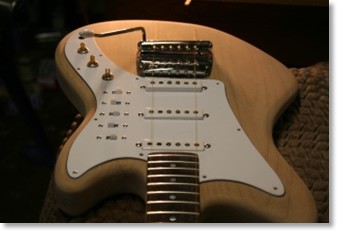
MARCH 2010 UPDATE - Since building this "Vox-a-like," I have been contacted by Brian who used to own and play an original Consort in the early 60's. Many many thanks to Brian for the photo below. Why did we always pose with THAT chord?.

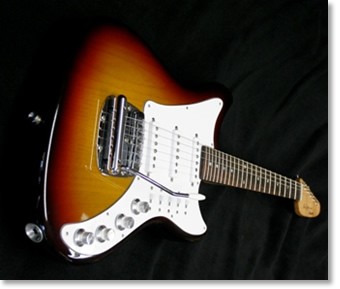
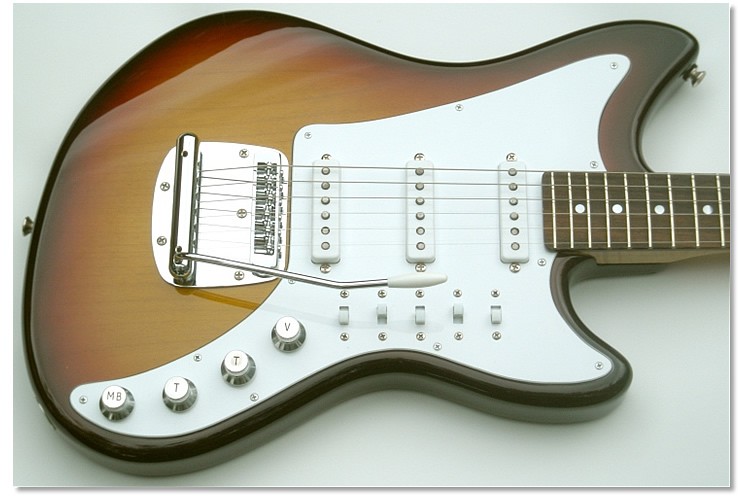
2009 Hybrid Variax/mags T type for America
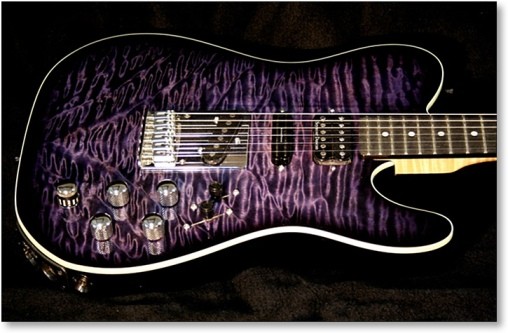
Coals to Newcastle or Tele's to Texas?
"Well I guess I only know those other two guys".
These were the words that convinced me that I had to build this guitar. Let me explain. I had received an email from a guy in Texas who was enquiring about a custom "T" type guitar with both regular pickups and Variax electronics. It was at the time when the British pound was worth two US dollars. I roughly priced up the guitar and suggested that the prospective customer seek an American builder as it seemed to me that every third person in the States was a luthier and this guitar would be considerably cheaper if it was built over there. That's when I got the reply, "Well I guess I only know those other two guys". I just knew that we would get on.
Erin turned out to be quite a character. He made jewellery and had made bespoke cycle frames. Judging by examples of his work, he was a perfectionist and above all, he had my sense of humour. The deal was done.
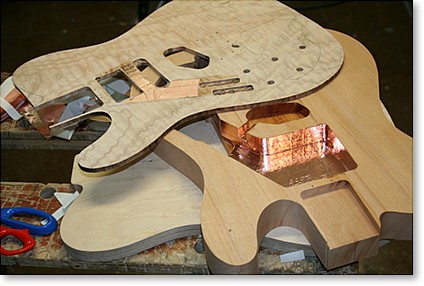
The spec. was a 'T' type guitar with a mahogany body, a bound top and no pickguard. It was to have a quilted maple, bolt on neck with ebony fingerboard, mother of pearl position dots and dual outputs for the magnetic pickups and Variax electronics. Literally two guitars in one, it would be a Variax and regular guitar, each with its own controls and switching systems. An outboard A/B pedal would select which "guitar" would feed the amp. Oh yes and it had to be purple!
Erin shipped his Line 6 Variax guitar and three Seymour Duncan pickups to me and work began. I had some stunning quilted maple for the top and decided that because the wood was so striking, I didn't really want to use any pickup surrounds. I decided that I could 'tunnel' the neck and middle pickups into position through the main electronic control cavity, after the maple top was glued to the mahogany body. This 'tunnel' was also copper foil shielded before gluing, as it would be impossible to do it later on.
All went well. Two of the mag pickups were coil split via push/pull mag. tone and volume controls. Two five way switches left the control cavity snug to say the least. The Strat style Variax bridge was swapped for a modern tele-style which was machined to take the Variax piezo saddles and cable. We added a shaved heel for upper access to the dusty end of the fretboard and a contour or "belly cut" to the rear of the body. The quilted maple neck was stiffened with two carbon fibre bars and a two way adjustable truss rod installed. So to the home straight, or so I thought . . .
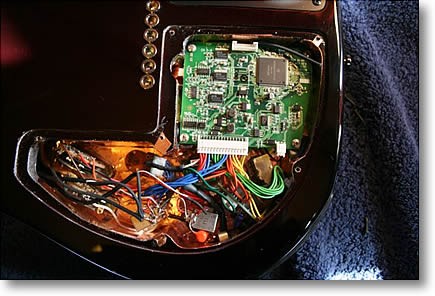
Erin had sent me a picture of Tom Anderson guitar with a quilted maple top, finished in a vibrant purple. The colour varied from violet to magenta and looked fantastic and rather foolishly, I had said yes of course I could do that, wrong! I spent three weeks with stains and dyes to try to capture the colours. I emailed Tom Anderson who, typical of the man, replied and said what he used. In the end, and to cut a very, very long story short, I settled on "NTA Purple" (Not Tom Anderson Purple!). It was a combination of triple staining, using dark blues and cherry reds, to get to the final result. Erin, bless him, accepted that I could do no more but I have to say that I did like the final result, very different colours and hues under different lighting conditions and the quality of the wood shone through.
So the finished guitar was shipped (another story altogether and praise for UPS whom I found very helpful from my end) and Erin seemed pleased. But talking of perfectionists, I did get an email asking why I had used slot headed screws on the humbucker and cross headed on the other two pickups, and you know what? I thought when I was fitting them that they should have been the same but Seymour Duncan "Gibby" style come with slotted and "Leo" style come with cross headed, BUT I should have sorted it! Next time I'll get it perfect.
My thanks to Erin - I know we will stay in touch. It's been an absolute pleasure sending coals to Newcastle.
2008 "Art" Electric guitar and two acoustics
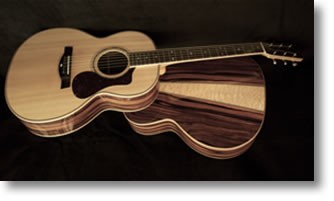
These two guitars came about by a series of odd coincidences.
Dave Burrluck had sent me a prototype electric guitar. It was one of two that had been designed, in collaboration with JHS's Dennis Drumm and Trev Wilkinson, and built in China as part of a feature Dave was writing for Guitarist magazine: Project China.
Along the way Dave hoped to create an inexpensive, but fully gigable, no nonsense workhorse for musicians on a budget. This particular prototype needed some attention, however, as it had a few teething problems. These were duly sorted and the guitar sent back to Dave.
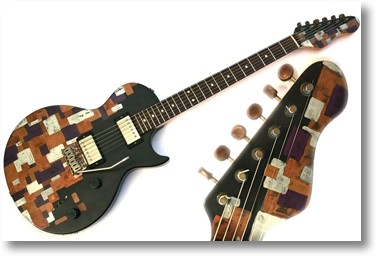
A month or so later I had to deliver one of my guitars, which was to be featured in Guitarist magazine, to Dave. He showed me the guitar that I had worked on which had now been transformed by his daughter, Lucy, into what they called the 'Art’ guitar.
Lucy was in her final year of her art A-level (she achieved an A grade, by the way!) and she’d hand-painted the body and head-facing using metallics and colours that matched the metal hardware after Dave had, severely 'aged' them with etching fluid! (Don't try it at home folks!).
Dave asked if I would lacquer over the paint to smooth and protect the artwork. I agreed and used a two-pack finish which I thought would do the job and give enough build to flatten back and polish.
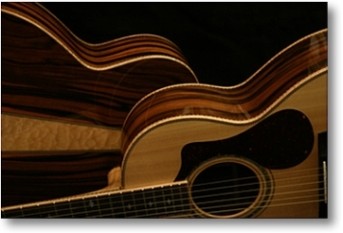
A while later I called to collect my reviewed guitar and to return the 'Art' guitar, which by this time I was quite fond of. Over a coffee, or two, Dave showed me an old Hofner Congress, a 15-inch wide cello-style acoustic from 1957 that he'd recently acquired for next to nothing. I immediately loved it - my very first guitar was a very similar style Aristone archtop.
What struck me was the shape. It reminded me of a one-of-a-kind flat top acoustic that I had built in 1964 for my friend, Rog - the bass player in my old folk band Hunter Muskett. I had re-built it for him a couple of years ago and I rather liked its 'non-American' shape. So, I drew round Dave's Hofner with the idea that I would compare it to Rog's guitar as I still had the original mould. The two were very similar - although I have no idea where I got my shape from - and an idea began to form about building a new acoustic using this Hofner shape.
I felt I owed myself a medium sized 'picker' but it had to have a good bass response as most of my recent acoustics had been in the Epiphone Texan drop-shouldered style.
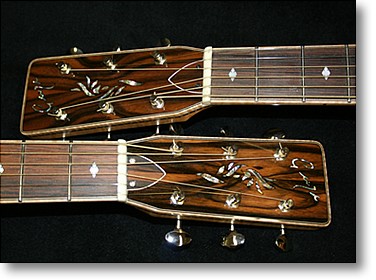
Now any guitar builder will tell you that when an idea hits, especially if it's for themselves, there is no stopping it. Ideas come and go, they change and various options offer themselves and then change again before you settle on a pretty firm picture of what you'd like. Eventually I decided on striped Maccassar ebony for back and sides but with a three-piece back featuring some startling quilted maple. The top would be Sitka spruce (for it's workmanlike appearance and character) and the neck would be triple spliced flamed maple with Maccassar ebony facings to front and rear of the simple headstock. The bridge also would be out of Maccassar ebony and all bindings in flamed maple, all purflings in wood. I fancied small snowfake inlays on a rosewood fingerboard and all other inlay would be in abalone. Machines were to be open vintage-style Gotohs in nickel.
So that was it, except that it wasn't! As this was a guitar for me I thought I should experiment further. I fancied an Earvana compensated nut and stainless steel frets. I wanted to try a bolt-on neck that some of the boutique big boys use and I wanted to use a bridge truss system that I could use to 'tune' the guitar with - it also prevents the bridge twisting and bellying the guitar's top.
But then I thought, if I was building one picker why not build two identical in every detail except their shape? I justified this on the grounds that it was now an experiment to determine the effect of the shape on the sound. Not really true, I might add, I just fancied making a slightly smaller picker with a shape I had used before and had very good results with. So that was it. and this time it was!
The two guitars are a delight. The bolt-on neck works well; the truss system does what it is supposed to and the combination of Maccassar ebony and maple makes me grin. The only problem I have is which do I prefer? If it was to be purely for finger-picking it would be the smaller, more parlour-sized model but the larger Hofner-styled guitar wins out with it's fuller sound. The experiment was a total success. although I had to build two guitars to find out!
Photos of the "Art" guitar courtesy of Lucy Burrluck
2008 Single cut gold top with three P90s
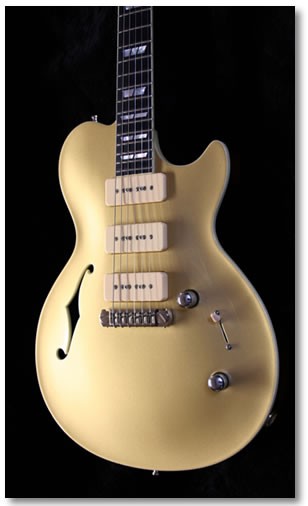
Considering that I am old enough to remember the original Gibson Les Paul Gold Tops it seems odd that it has taken me until now to really appreciate their beauty.
Many, many years ago when I made my first Candy Apple "Strat" I can remember liking the gold base coat on the guitar before adding the translucent red but it never seemed appropriate to finish a guitar just in gold.
Rather more recently Gold Tops have seemed to have cropped up more and more, a headstock repair on a Gibson, a heavily (intentionally) distressed PRS, an Epiphone fret dress and a request to build a nearly traditional Gold Top. I was smitten.
It was the Gold Top build that really did it. The colour seemed to add more shape to the guitar somehow and I thought it would be good to do one in my single cut shape that I had previously reserved for my Variax equipped guitars.
As this was going to be a "special" I thought that I would indulge myself and equip it with my wish list of parts and perhaps experiment at the same time. The body would be my single bound single cut shape out of mahogany with a carved top also out of mahogany (I usually use figured maple). I wanted a robust Les Paul Junior response especially as it was going to be loaded with P90s. The neck, also out of mahogany, but triple spliced, was to have an ebony, rather than perhaps a more appropriate rosewood, board purely out of personal preference. It would be a set heeless neck that I developed for this shape. Matching binding would frame the neck and headstock and "F" hole and all inlays were to be pearl. Scale length was 25 inches with my favourite 12 inch radius and a compensated nut, as I had put a couple on some recent guitars.
Choice of hardware was TonePros top locking tuners with slightly longer barrels than normal as my head stocks are tapered from 15 to 16.5 mm (The more common "low profile" lockers are too short) and the very stable TonePros stop bridge/tailpiece was to transmit maximum vibration to the body. In my heart I'm a single coil man but I wanted something more, so it was to be three P90s together with a five way switch. The P90s were to be "Bareknuckle" who wound me a matching set (very nice guys!) The mid one was reverse pole/reverse wound for hum cancelling in positions two and four.
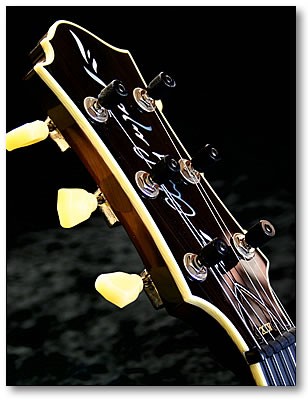
I wanted a simple control set up, a single volume and single tone control but the volume was to have a treble bleed capacitor and resistor to keep the brightness when rolling down the volume and I experimented with different values of capacitor for the tone control.
As I had recently built a couple of Tele type guitars I grew very fond of the "both pick ups on" mid position on a Tele and so I added a push/push switch to the tone control which switched in the bridge pick up, so in position five I could have neck and bridge, and position four gave me all three pickups giving a total of the seven possible combinations. As P90s are single coil I used copper foil screening inside the covers as well as throughout the control cavities to keep out as much "noise" as possible.
The guitar is finished in nitro cellulose lacquer and I mixed my own gold after experimenting with three different bronzing powders. The rest of the guitar is finished in my favourite "Tobacco burst".
What I like most about this guitar is its versatility. I love the positions two and four as on a Strat you get that mid scooped "in between" sound and with the volume rolled down a little you can do a passable "Sultans" impression. Roll the volume down even more and an almost acoustic rhythm sound ideal for background strumming fills can be obtained. Roll thing full on and we're right into Les Paul Junior rock country. Could it be my ideal guitar?
Probably. . . . . . until the next one.
2007 "R" style electric 12 string
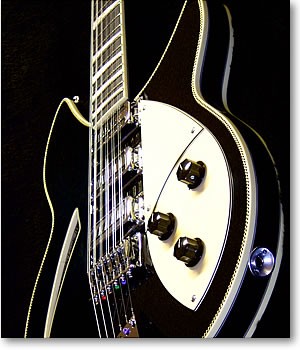
This custom build came about really by accident. A customer of mine had a custom 6 string and decided that he would like a matching 12 string. The 6 string was my custom classic carved maple top single cut, with tobacco burst finish and we both thought that the 12 stringer would be a matching "bookend".
I have two electric 12 string "Ric" type guitars that I had built for my band and I let Frank have a play as they had different neck profiles (both much wider than a real "Ric") and wanted to see which he preferred. One of the guitars, a Lennon style 325, was finished in black with chrome hardware and cream bindings and along with magnetic pick ups it also had a "Headway" piezo saddle with "preset" controls accessed via the slash sound hole to give a very good interpretation of an electro acoustic.
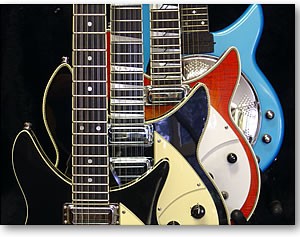
Frank took this guitar home just to make sure that the neck and sounds were what he wanted. About a month later I had to wrench the guitar back from him and by now he had completely changed his mind and wanted this guitar or one very much like it.
We decided on a model 360/12"Ric" type (more Harrison than Lennon) with three toaster top pick ups and a 5 way selector giving the nice acoustic-ish positions 2 and 4 rather than the piezo bridge system. All hardware was to be chrome with cream bindings and scratch plate. Black nitro cellulose finish set off with fine black/white linings to the sides, back and neck and black and white herringbone purfling to the front. The ebony fingerboard with real Mother of Pearl inlays completed the spec.
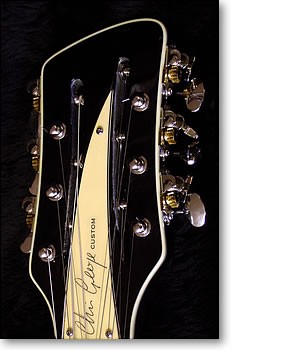
The build followed the traditional "Ric" pattern with the front and back being made out of solid wood and hollowed out and the back glued on later. We did digress slightly and recess the pickups into the top to give a lower string height and chose a bridge with individually adjustable saddles but more importantly to give a wider string spacing than an original "Ric" (Frank has big hands!). The observant amongst you will have noticed that six strings terminate at the bridge whilst 6 go to the traditional trapeze tailpiece.
I have always been a huge fan of 'Ric" guitars, especially the iconic John Lennon model, and, whilst this guitar has many differences, I was really pleased with the finished product - more importantly so was Frank, who's band is rumored to be rehearsing Byrds and Tom Petty numbers and, if I hear that introduction to "Hotel California" again, I will scream!
